:max_bytes(150000):strip_icc():format(webp)/GettyImages-917461864-7141ebd3ec944ce6a431b8d485cc9cdb.jpg)
Updated 2024 Approved Whats Next After Movie Maker? 10+ Video Editing Alternatives

What’s Next After Movie Maker? 10+ Video Editing Alternatives
Windows Movie Maker has been a cornerstone tool for video editors for quite a while. There are a lot of amateurs who’ve made use of the free program and have done wonders with it. As it is discontinued, many Windows Movie Maker alternatives claim to offer ‘just the right video editing tool for you,’ few can live up to their promises—and most are very expensive.
We have ten other programs that can be used to create videos that include everything from Apple iMovie to other basic alternatives.
So whether you’re a beginner who wants to learn how to make a movie, a pro looking for an excellent alternative to Windows Movie Maker, or someone who wants to make a simple slide presentation or online video, you’re bound to find a video creation program here.
- Wondershare Filmora
- Avidemux Video Editor
- VirtualDub
- Sony Vegas Movie Studio
- WeVideo
- Lightworks
- ShotCut
- OpenShot
- Movavi Video Editor Plus
- VSDC Free Video Editor
- VideoPad Video Editor
- HitFilm
- Magix Movie Studio
- How To Edit a Video With a Windows Movie Maker Alternative
- Hot FAQs on Windows Movie Maker Alternatives
Part 1: Top 3 Picks for Windows Movie Maker Alternatives
The world’s best video editing software is about to change. We look at three of the most popular and valuable alternatives to Windows Movie Maker.
You will need to consider these alternatives to ensure they meet your expectations and needs.
1. Wondershare Filmora - Best Overall

Filmora is the best Windows Movie Maker Alternative designed according to your convenience.
Ratings: 4.4 Stars out 5
Starting from $49.99
2. Magix Movie Studio - Best for Collages

This alternative offers a variety of tools and plugins for anyone who wants to create professional-level videos in under a minute.
Download on Windows
Ratings: 4 stars out of 5
30-day free trials, then starts from $69.99 all the way to $129
3. Avidemux Video Editor - Best Open-Source Editor

An open-source editor that supports a wide range of formats is free! Avidemux has an interface similar to Windows Movie Maker, which makes it a perfect alternative.
Download on Windows
Ratings: 4.0 stars out of 5
Free Trial
Part 2: Ultimate Overview on 13 Best Alternatives to Windows Movie Maker
We live in visual culture, and we constantly see, capture, upload, and share videos on our smartphones, tablets, and laptops. So, it is only natural that more people seek ways to edit their videos. Windows Movie Maker was one of the most popular video editing apps. So it’s time to dig into the best Windows Movie Maker alternatives, which are arguably better and feature-rich.
| Software | OS | Media Resources | AI editing | Easy to Use | Free Trial |
|---|---|---|---|---|---|
| Wondershare Filmora | WindowsMacMobile | Yes | Yes | Yes | Yes |
| Avidemux | WindowsOS XLinuxBSD | Yes | No | Yes | Yes |
| Virtual Dub | Windows | No | No | Yes | Yes |
| Vegas Movie Studio | Windows | Yes | Yes | No | No |
| WeVideo | Online | Yes | No | Yes | Yes |
| Lightworks | LinuxOS X Windows | Yes | Yes | No | No |
| ShotCut | WindowsMacLinuxBSD | Yes | No | No | Yes |
| OpenShot | WindowsMacLinuxChrome OS | Yes | No | Yes | Yes |
| Movavi Plus | WindowsMac | Yes | No | Yes | Yes |
| VSDC | Windows | Yes | No | Yes | Yes |
| VideoPad | WindowsMaciPad/iPhone | Yes | No | Yes | Yes |
| HitFilm | WindowsMac | Yes | Yes | Yes | Yes |
| Magix Movie Studio | Windows | Yes | Yes | No | Yes |
Part 3: 13 Best Windows Movie Maker Alternatives for Windows
As we all know, Windows Movie Maker is the most used and trusted tool for creating videos in Windows. With its unique features and user-friendly interface, people often use this software to develop short and entertaining videos.
However, the fact is that Windows Movie Maker is not the current best video editing software for creating complex video projects. For this reason, we compiled a list of the 12 best alternatives to offer you a better option for Windows Movie Maker.
1. Wondershare Filmora
Filmora 11 is a powerful, easy-to-use video editor specially designed to streamline your workflow and save you hours weekly. It supports everything from Windows, Mac, and IOS to Android. The latest update to the flagship app includes several key enhancements that result in a much more efficient video creation workflow and one that’s easier to use than its rivals.
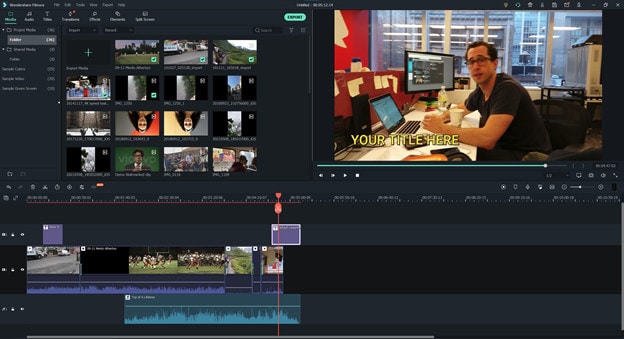
Key features
- Preset Templates
- Instant Mode
- Motion Tracking
- AI Editing Effects
- Auto Synchronization
- Plug-ins
Price
- Annual Plan: $49.99
- Perpetual Plan: $79.99
Pros
- Seamless interface for beginners
- Great customer support
- Plenty of effects and preset templates
- 4K video output options
Cons
- Rendering requires too much time
- The mobile app requires separate subscription
Supported OS: Windows , Mac , iOS , Android , iPad
G2 Ratings: 4.4 stars out of 5
Summary
Filmora’s intuitive interface allows experienced and brand-new users to create incredible videos with flawless special effects. Its high ratings and multiple supported formats make it quite popular among users.
2. Avidemux Video Editor
If you are a beginner and want to use a free, open-source software program for basic video editing, then Avidemux is a good choice. The interface is not as fancy as it could be, but there are some presets that’ll save you a lot of time. Avidemux is a cross-platform video editor that allows you to create custom videos, but it doesn’t feature the ability to share the edited footage to social media directly,
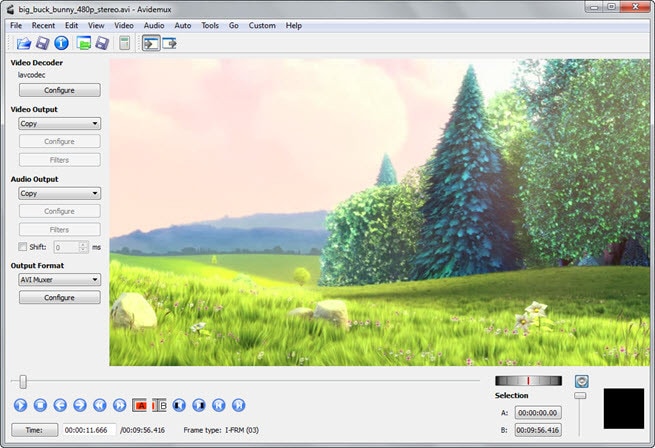
Key features
- Video and Audio Filters
- Support Popular Formats
- Convert Video For Archiving or Publishing
Price: Free
Pros
- It can convert Video To A Smaller Size
- Easy cut, trim, split video
Cons
- Out-dated UI
- Lacks sharing option
Supported OS: Windows , OS X , Linux , BSD
Uptodown Ratings: 4.0 stars out of 5
Summary
An open-source video editor that supports most formats. Due to its obsolete UI and lack of sharing features, Avidemux has average ratings.
3. VirtualDub
This open-source software is user-friendly and allows users with little experience to navigate the software without much trouble. It supports 3rd party apps and also offers batch-processing, which means working on multiple videos simultaneously makes it possible.
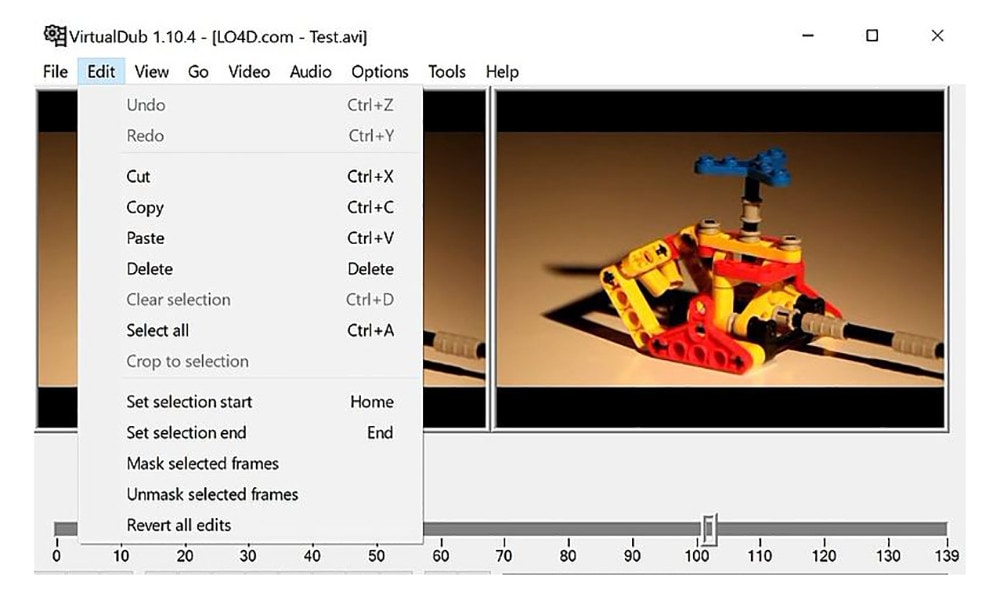
Key features
- Integrated volume and histogram meter
- Optimized disk
- Noise reduction
- Fractional frame rates
Price: Free
Pros
- Clean interface, easy to use
- Keyboard and mouse shortcuts for faster operation
- Free to use
Cons
- Not suitable for 4K editing
- Lack learning material
- Obsolete Interface
Supported OS: Windows
Compare Camp Ratings: 4.0 stars out of 5
Summary
Virtual Dub supports multitasking, and its features are pretty helpful. However, it lacks 4k editing and a friendly interface. Overall Virtual Dub is a good choice.
4. Sony Vegas Movie Studio
This video editing software makes it easy to create professional-looking videos in minimum time and effort. Vegas Movie Studio software is best for video editing professionals who have been doing it for some time and are looking for something a little more sophisticated than free alternatives. Not only does it has a high retail price, but its internal elements can be too complex for those just beginning.
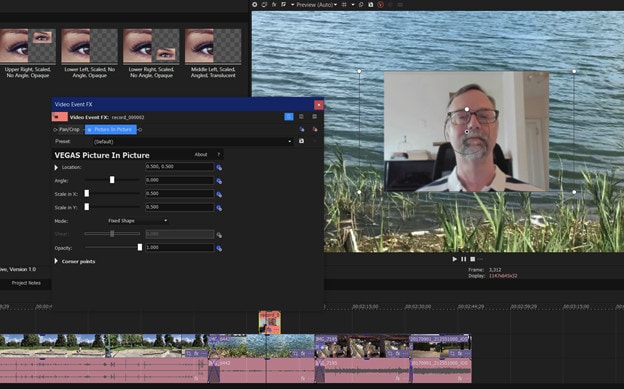
Key features
- Color correction
- HDV and AVCHD-editing
- DV batch capture
- Wide variety of file formats and codecs
Price: Starting from $7.99 USD per month
Pros
- Customizable interface
- Multicam editing
- Lots of effects and transitions, with plug-in capability
- Good slow motion and warp flow transition tools
Cons
- Less intuitive interface than competitors
- Import from camcorder not ideal
- Some tools are complex
Supported OS: Windows
G2 Ratings: 4.4 out of 5
Summary
Vegas Movie Studio is the choice of professionals. It does all the work without taking up a lot of resources, and like most programs, there is a learning curve. It’s not always intuitive for beginners, but its professional and powerful features score decent in most reviews.
5. WeVideo
This cloud-based application is a simple-to-use video editing and sharing suite. WeVideo is a full-featured video editing application that uses JumpStart technology to create amazing videos. It’s an innovative app that offers a seamless editing experience as it supports multiple formats of video, images, audio, and graphics.
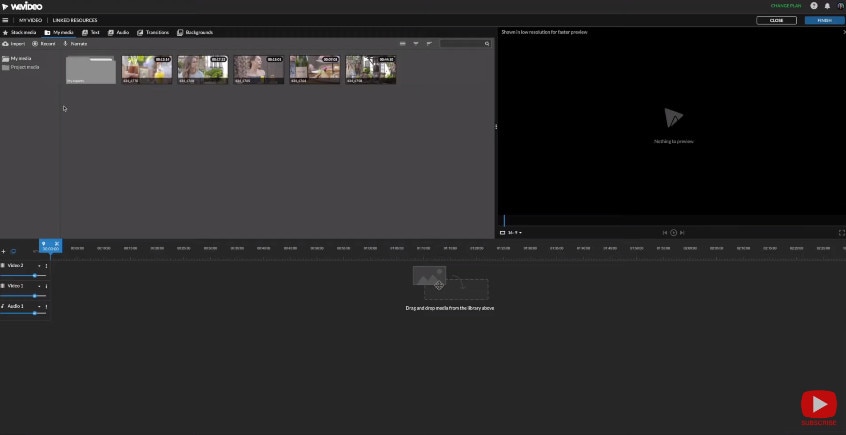
Key features
- WeVideo JumpStart
- Cloud storage
- Built-in graphics
- Customizable environment
- Advanced text editing
- Multi-track editing and storyboard
Price
- Free trial
- Power Plan: $9.99/month
- Unlimited Plan: $15.99/month
- Professional Plan: $39.99/month
- Business Plan: $73.99/month
Pros
- Constantly improving features
- Ease of use
- Storage is cloud-based
Cons
- Old fashion transition
- Leaves a watermark on free trial
Supported OS: Online
Trustpilot Ratings: 4 stars out of 5
Summary
WeVideo is a straightforward yet robust video editor. It offers a variety of features and supports multiple formats, plus its comprehensive pricing plan makes it useful for everyone.
6. Lightworks
Lightworks is the most powerful video editor in its class and an excellent tool for professionals who want to make amazing videos quickly. Lightworks is very fast and straightforward to use, and it has some great features you won’t find in any other video editor. It is available on all popular OS.
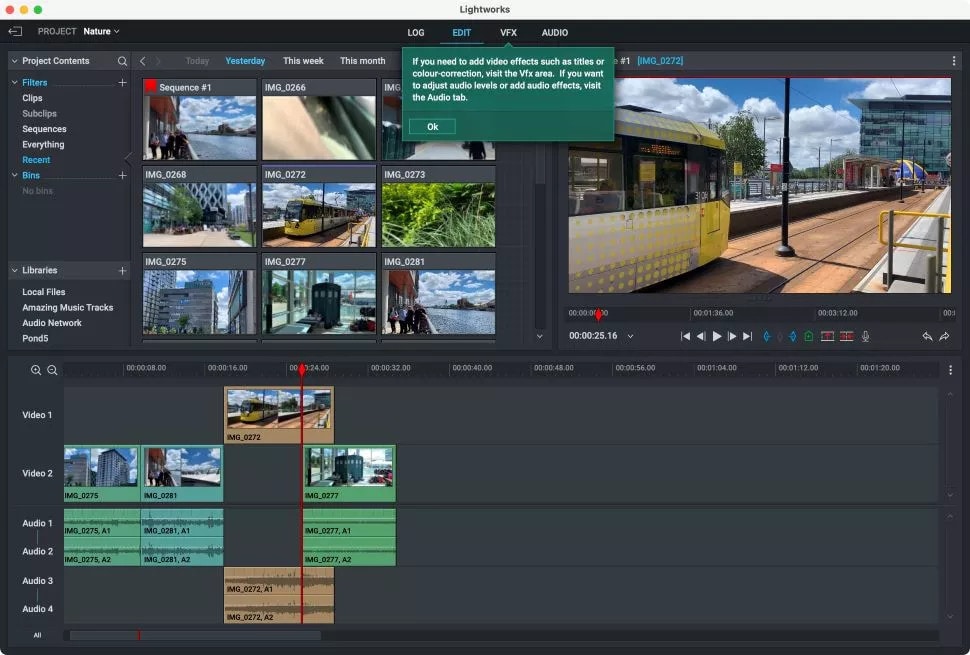
Key features
- Audio and Video Effect Plugin Support
- Cloud Connected
- Motion Graphics
- Advanced Metadata
- Proxy Workflows
- Apple ProRes decoding
Price
- Monthly Plan: $9.99/user
- Yearly Plan: $9.99/user
- Perpetual: $154.99
Pros
- High-resolution timeline rendering
- It has social media export templates
- Interfaces for multiple OS are consistent
- Instant autosave
Cons
- Commands are not always intuitive
- A bit pricey as compared to its competitors
Supported OS: Windows , Mac , Linux
Techradar Pro Ratings: 4 stars out of 5
Summary
Lightworks is not any other video editing tool available on the market of video editing tools. This video editing tool provides amateurs with the most sophisticated features in an optimized platform. Its scores are the highest on almost every review site.
7. ShotCut
Shotcut is a multiplatform video editor that lets you work with various formats for audio, video, image files, etc. This video editor makes it easy to mix and match the resolution and frame rates in a video file. All the changes you make in the editor can be undone and redone often. Shotcut is the best choice for video editing, without question.

Key features
- Webcam capture
- Audio scopes and filters
- Deinterlacing
- Eyedropper tool
- Video wipe transitions
- Keyframes for filter parameters
Price: Free
Pros
- Support for 4K resolutions
- Free
Cons
- Less intuitive than commercial apps
- Lacks built-in sharing to popular sites
Supported OS: Windows , Mac , Linux
GetApp Ratings: 4.5 out of 5 stars
Summary
Shotcut is an open-source video editor for creative professionals and is available on mac, Windows, and Linux. The free version of Shotcut has many excellent features, but it doesn’t have the slick interface or advanced techniques of the top paid editors.
8. OpenShot
An award-winning open-source video editor that creates stunning videos. OpenShot is a fast, easy-to-use, and surprisingly powerful video editor. OpenShot Video Editor allows you to work with many different types of tracks so that your edits will seem natural. OpenShot Video Editor allows you to add your custom animations or titles. The options are endless, so it all depends on your time and interest. It is available in more than 70 languages, making it ideal for all types of users.
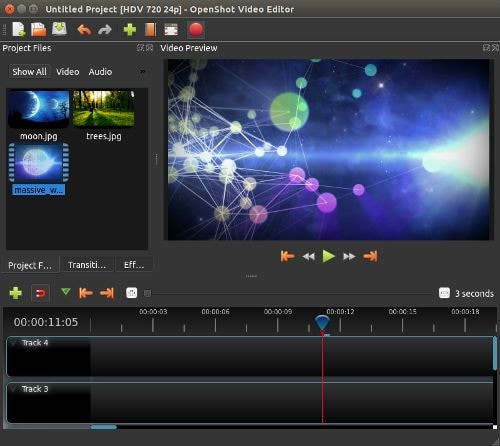
Key features
- 3D animations
- Animation and keyframes
- Multiple languages and formats
- Cross-platform
- Video-effects
Price: Free
Pros
- It is a non-linear editor with infinite tracks
- 100% free without watermark
- Frequent updates
Cons
- Obsolete interface
- Unstable performance
- Lacks some editing features
Supported OS: Window , Mac , Linux , Chrome OS
Getapp Ratings: 4.2 stars out of 5
Summary
Another open-source video-editor in the list is named OpenShot. It’s a multi-lingual and multi-supported app with unique features. Despite its unstable performance, OpenShot is still an ideal choice for many users.
9. Movavi Video Editor Plus
Movavi Video Editor Plus is the perfect tool to bring your creative ideas to life. It has special effects, ready-made intros, and keyframe animation. Using chroma keying, you can change the background of your video clips to any color or pattern that suits your need. Movavi has now redesigned its user interface to make it easy to use.
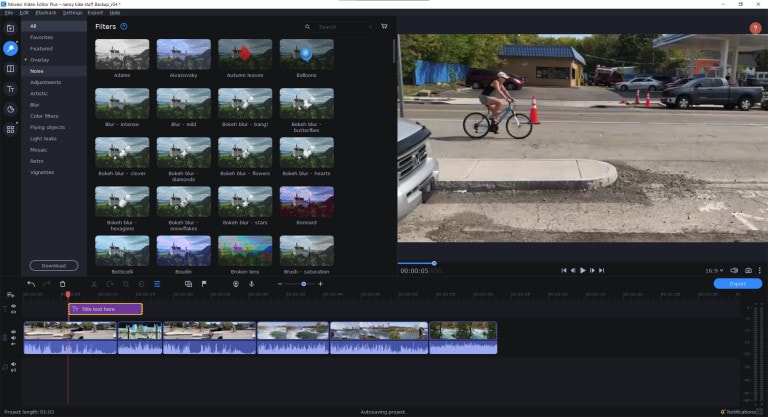
Key features
- Effects and transitions
- Built-in media pack
- Fast processing of 4K videos
- Keyframe animation
- Automatic video creation
- Cutting, trimming, joining
Price
- Free version: 7 days
- Video Editor Plus 1 year /1 PC: $49.95
- Video Editor Plus Lifetime /1 PC: $69.95
- Video Suite Lifetime /1 PC: $89.95
Pros
- Easy-to-understand user interface
- Transitions with sound
- Motion tracking and picture-in-picture tools
- Chroma-key capability
- Quick movie-creation tool
Cons
- Lacks advanced trim modes
- Slow rendering
PCMag Ratings: 4.0 stars out of 5
Summary
If you want to edit your videos with a minimal learning curve, try Movavi. You get PiP, chroma-keying, titling, basic keying, and motion tracking. The program is simple to use but doesn’t have all the features and stands four stars.
10. VSDC Free Video Editor
VSDC Free Video Editor is an online tool that lets you edit audio and video files to make your creations like movies, YouTube tutorial videos, and more. The audio and video files supported are extensive, and the software includes a codec manager. The Pro version isn’t necessary if you’re using the free edition of the software; it’s more than enough to get the job done.
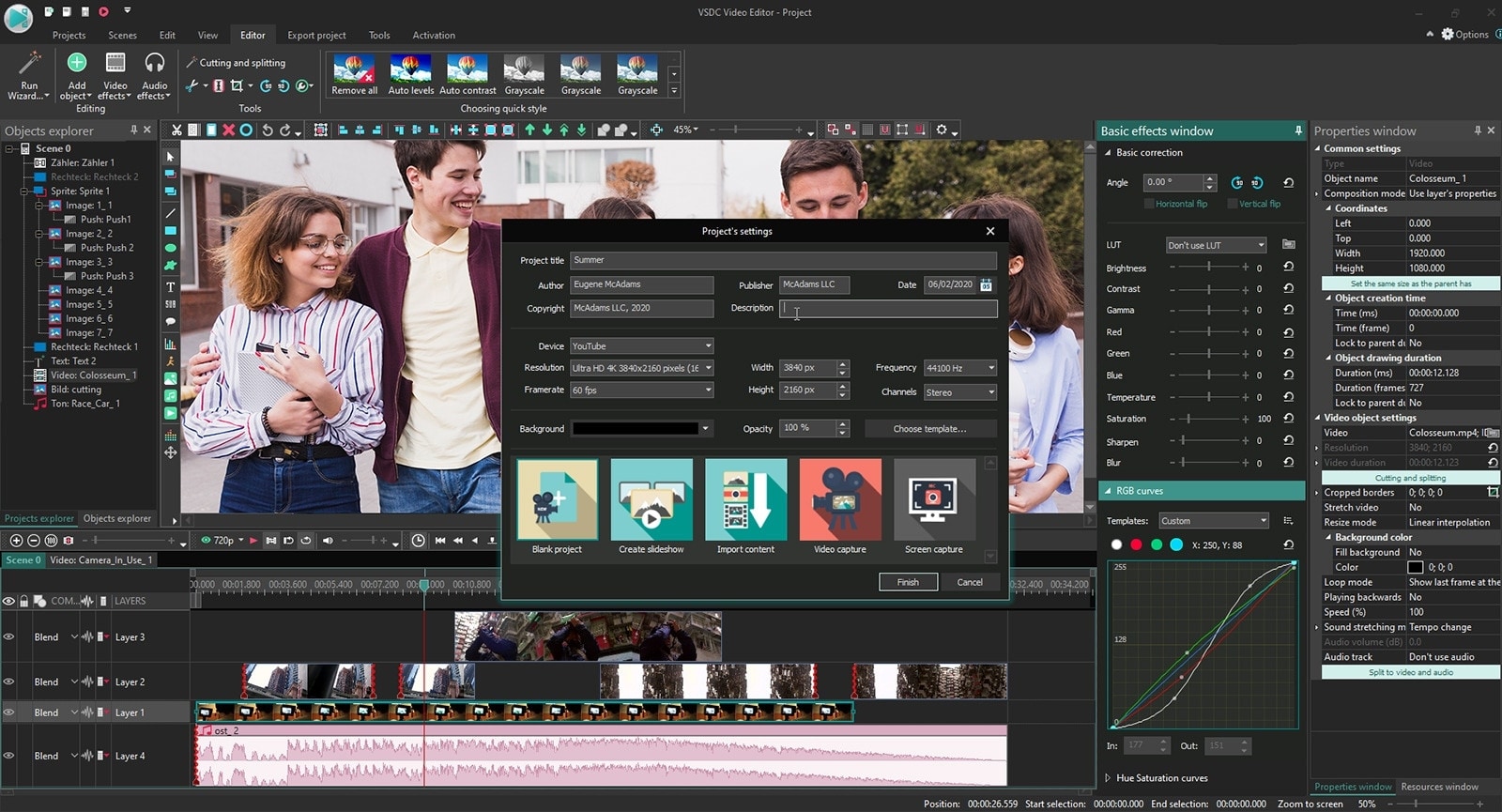
Key features
- Dark theme
- Subpixel Accuracy
- Powerful Chroma Key tool
- Trendy video effects, filters, and transitions
- Color Blending And Filters
- Built-In DVD Burning Tool
Price: Free
Pros
- Non-linear
- Video effects library
- Video stabilization
- Masking
Cons
- Outdated interface
- Lack keyboard shortcuts
- Only available on Windows
Supported OS: Windows
Capterra Ratings: 4.5 stars out 5
Summary
VSDC is a non-linear editor with extensive format support. It includes all the essential features an editor requires but with an obsolete UI. It is also ideal for many who need a powerful yet free video editor.
11. VideoPad Video Editor
VideoPad is a free video editor that can create stunning videos and perform basic editing tasks. A good video editor can help you to create videos for different social media platforms. You can make your videos look professional and polished with a few clicks and some simple editing skills. There’s nothing particularly exciting or advanced about this app; it’s simple enough for anyone new to video editing or even for seasoned editors. But the simple and easy-to-use interface makes the entire process very exciting.
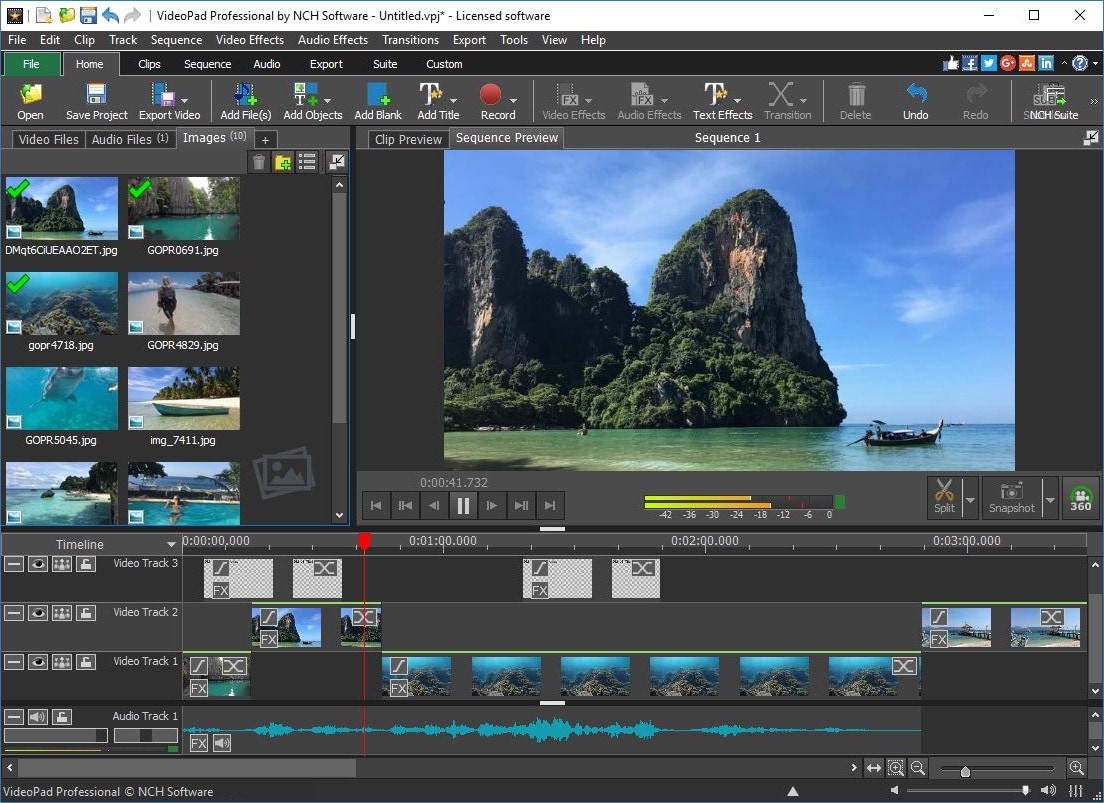
Key features
- Text snippets
- Range of transitional effects
- Plug-ins Library
- Burn finished videos to Blu-Ray, DVD, etc.
- Color correction and light balance.
Price: Free
Pros
- Simple and clean interface
- Supports multiple file formats
- Includes video effects
- Lightweight on system resources
Cons
- Lack of advanced features
Supported OS: Windows , Mac , iPad/iPhone
Tom’s guide Ratings: 3.5 stars out of 5
Summary
Video pad is a free video editor designed for beginners that is lightweight and simple. VideoPad is also great for creating quick videos for social media purposes like Youtube and Facebook. The software has a high rating, as shown above, and it’s available on Windows.
12. HitFilm
HitFilm is a helpful video editing software that makes editing easier for users. In addition to basic features, the program also provides advanced-level functions that make edited videos pop. Hitfilm Express Download has more than 400 features to help casual video editors save time. Features like: visual effects, cinematic elements, and compositing tools preset help unleash your creativity.
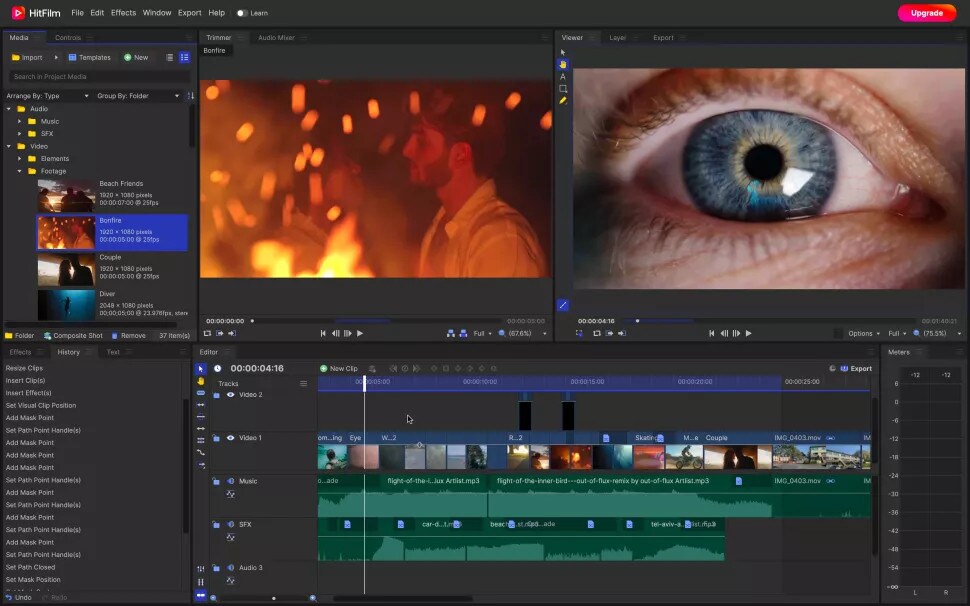
Key features
- Color Grading and correction
- Smart search
- Commentator recorder
- Lightning and lens flares
- 3D camera tracker
Price
- Free trial
- Creator: $7.50
- Pro: $12.50
- Enterprise: Custom pricing
Pros
- Intuitive interface
- It offers free tutorials and masterclasses
- Works on both Windows and Mac
Cons
- It requires heavy system requirements
TechRadar Ratings: 4.5 stars out of 5
Summary
HitFilm Express 15 is a powerful free video editing program that enables you to create high-quality videos in minutes with an intuitive interface. It offers advanced editing features such as advanced video trimming, 3D editing, and more.
13. Magix Movie Studio
Magix is the world’s leading professional audiovisual media software, with Sequoia being its industry-standard audio editing software. This movie editor is an enthusiast-level video editing software that competes with software from Adobe and CyberLink, and it even boasts support for 4K content and 360 degrees. There are many reasons to upgrade. This year’s update includes stabilization, 8K editing, motion tracking, and an in-app plug-in store.
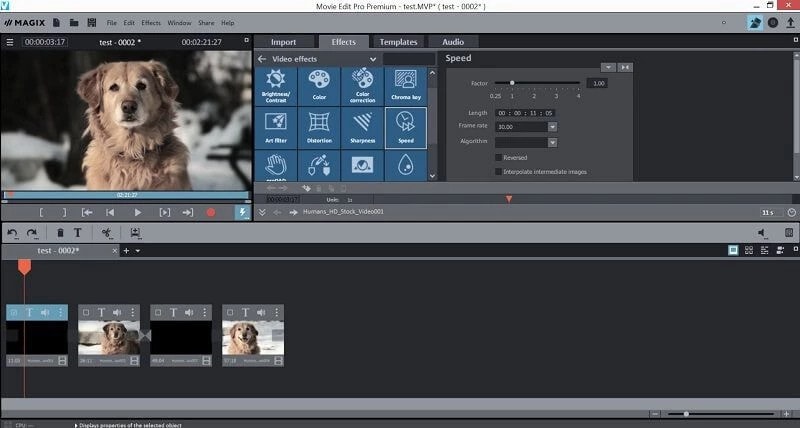
Key features
- NewBlue effects
- Fly-in animation
- New filter view
- Stabilization
- Motion tracking
- 8k support
Price
- Movie Studio 2024: $69.99 (30-day free trial)
- Movie Studio 2024 Platinum: $99.99 (30-day free trial)
- Movie Studio 2024 Suite: $129.00 (30-day free trial)
Pros
- Lots of video effects
- Responsive editing interface
- Multicam
- Trailer-like movie templates
- Solid audio editing
Cons
- Slower project rendering than others
- Lacks import and organization tools
Supported OS: Windows
PCMag Ratings: 3 stars out of 5
Summary
Magix movie studio is a powerful all-around video editing tool with many features that professional users have come to expect. It’s also relatively simple to use. But usability and performance are poor compared to other software programs like Filmora .
Part 4: How To Edit a Video With a Windows Movie Maker Alternative
Windows Movie Maker was great for editing a video, but it’s no match for some of the best video editing software. We’re talking about software capable of creating a cinematic experience in seconds, all on your computer.
When you need to edit a video with simple, quick edits, like adding a special effect or changing the background, try Filmora . Filmora is an easy-to-use application that allows you to create a movie using simple tools that don’t require additional training. You can’t beat this option if you want to create a professional-quality video for your blog or website.
Let’s dive into a quick tutorial on editing videos in Filmora:
Free Download For Win 7 or later(64-bit)
Free Download For macOS 10.14 or later
Step1 Open Wondershare Filmora on your PC or Mac
You can start a new project by clicking on ‘New Project’. And you can also change the ‘Aspect Ratio’ according to your project demand.

Step2 Import Videos
You can import your file by clicking the import tab on the upper-left side or clicking the import icon on the main window.
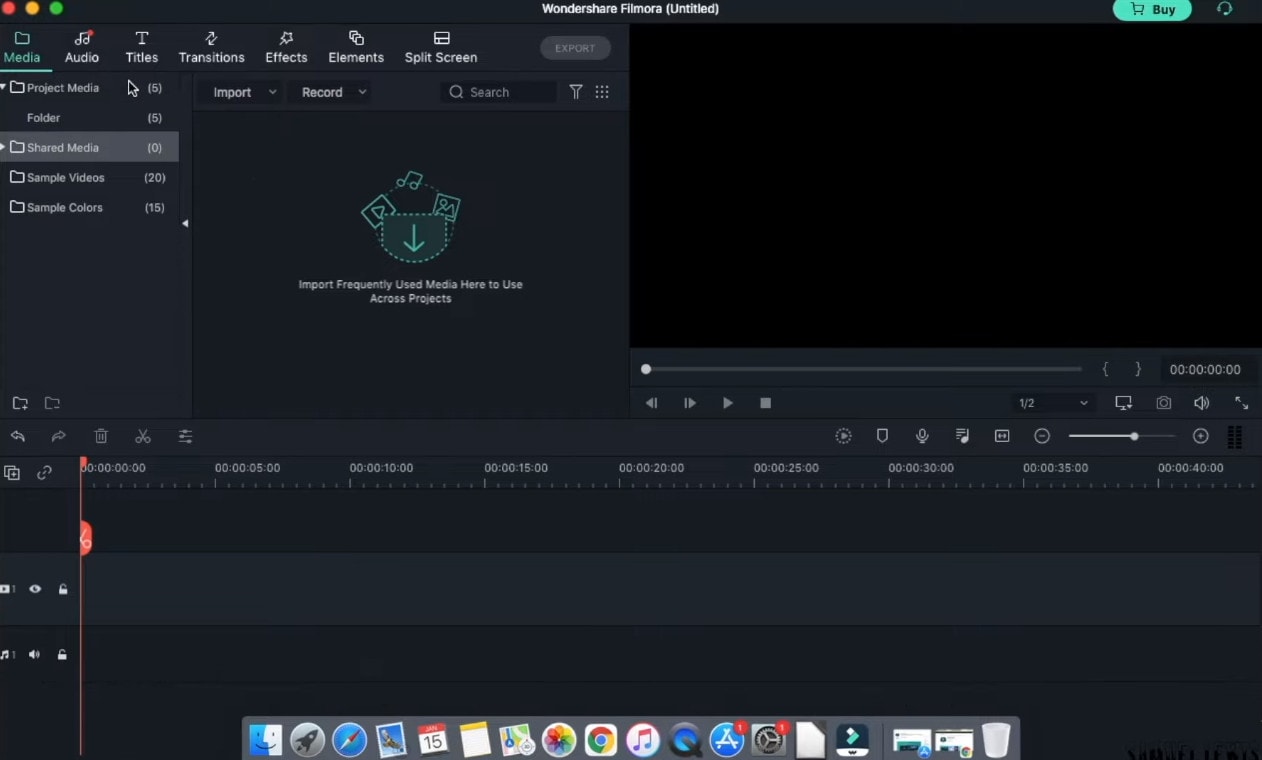
Step3 Drag and drop your footage to the timeline
After importing all the files, click and hold each individual video and drag and drop it to the timeline area according to your ideal sequence.
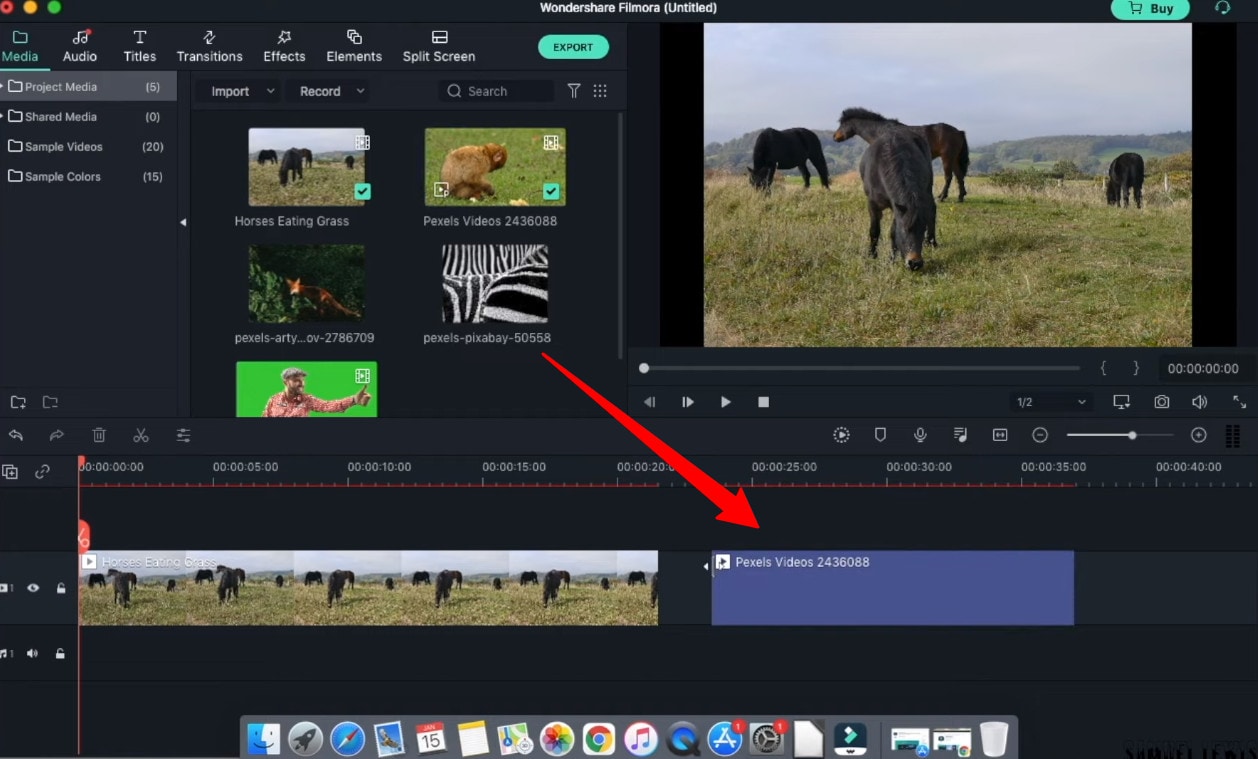
Step4 Add Audio
Go to the ‘Audio’ tab and select the audio file from the audio library. Once selected, drag and drop the audio file into the music timeline.
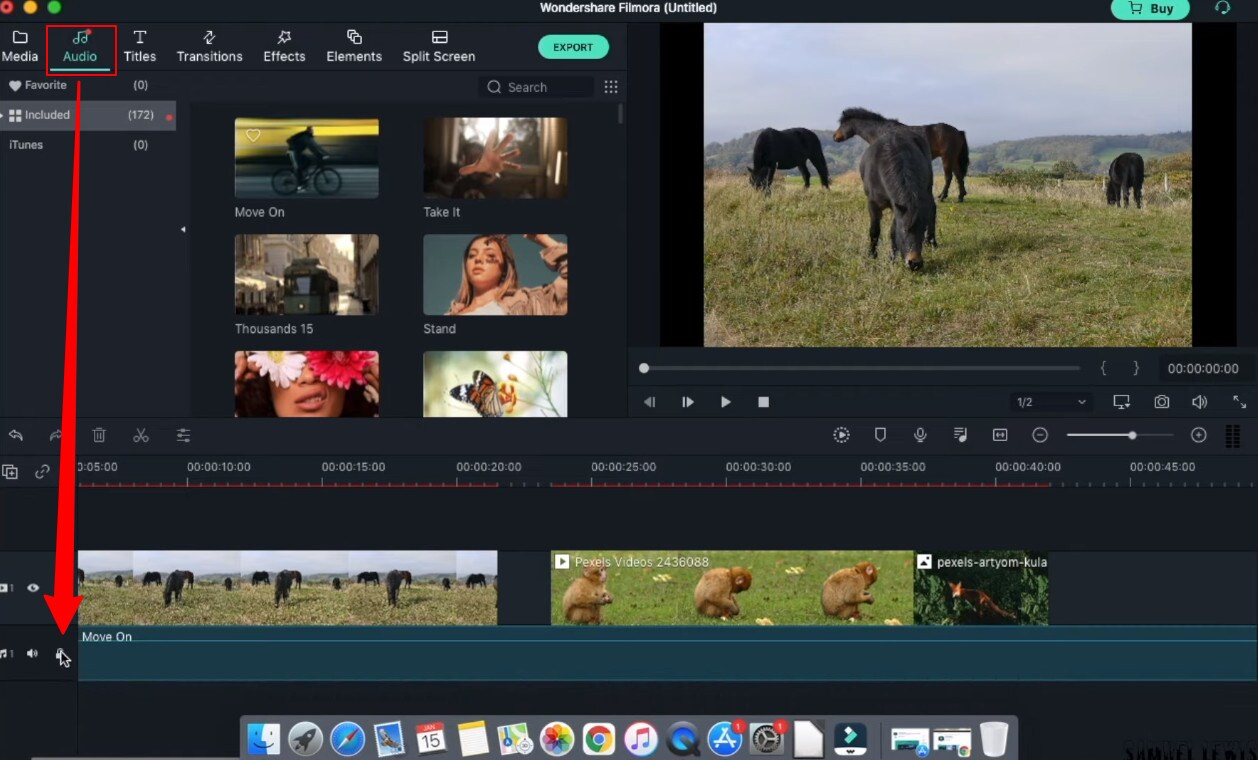
Step5 Add Titles
In your video intro, you can insert some title text. Go to the ‘Titles’ tab and select the one you like, and drag and drop it on top of the timeline. Double-click and edit the text and state your ideal statements. You can customize your text fonts and color too.
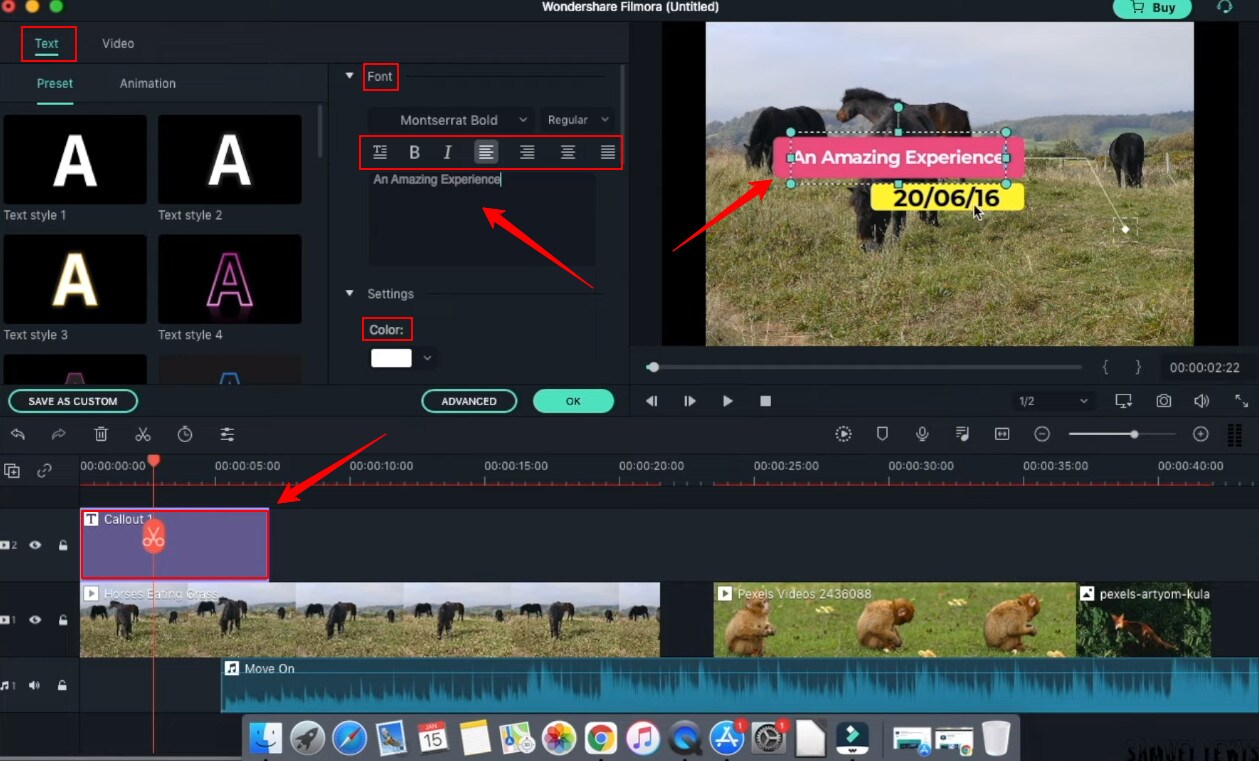
Step6 Add Transitions
You can add transition effects to ensure a smooth transition from one scene to another. The overall will get more professional look.

Step7 Add Effects
Next; you can get special effects to your video to make them more attractive and engaging to watch. Simple drag down the effect to your video and watch the effect take place in your selective scene.
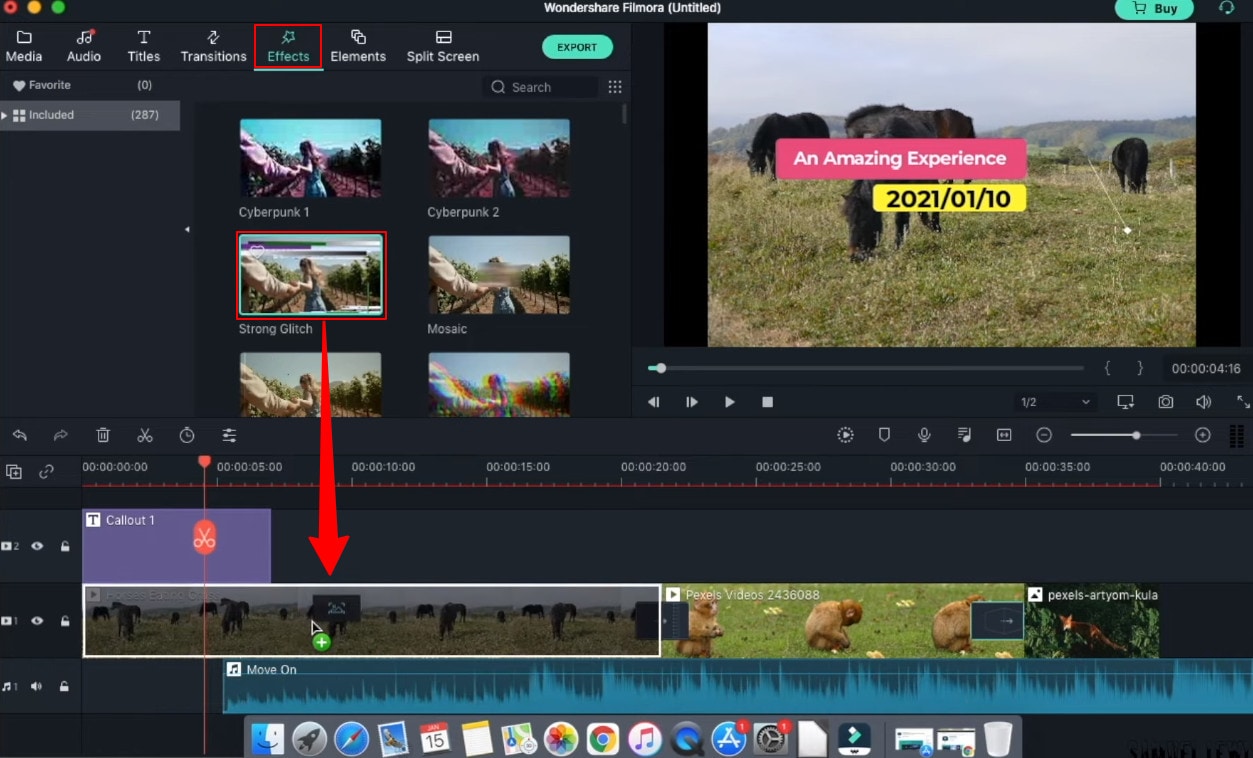
Step8 Export your work
Once all the changes have been made, hit ‘export’ from the top tab. A window will appear where you can change the settings, resolution, frame rate, bit rate, etc. Next, click the ‘export’ button down on that window, and then you can save the file in your drive.
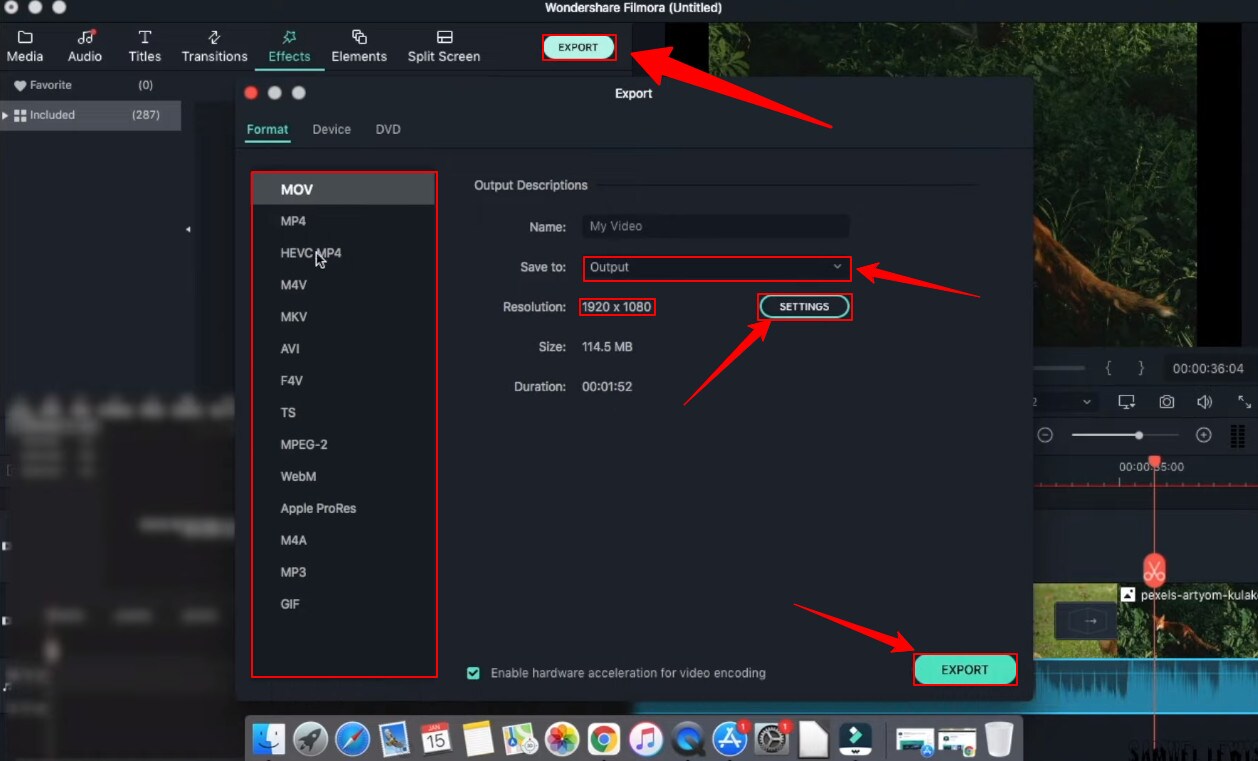
Part 5: Hot FAQs on Windows Movie Maker Alternatives
1. Why is Windows Movie Maker discontinued?
Microsoft’s video editing program, Windows Movie Maker, did not become a big hit with the public because it failed to do well on the market. Microsoft couldn’t get the support they were looking for from the program’s users. As a result, Microsoft had to cease its support of the program.
2. Is there a free version of Windows Movie Maker?
Microsoft Windows Movie maker was always accessible and pre-installed every windows product. Microsoft has discontinued support for Movie Maker and warns about free downloads of Movie Maker provided by third parties that might contain malware, viruses, or other issues.
3. What are the best free Windows Movie Maker Alternatives for Mac?
After switching to a Mac, you’ll find that the Windows Movie Maker alternatives offer much more than just a simple video editor. They provide advanced features, easy transitions, and less technical know-how to create pro-quality results. You should try using these platforms on your Mac if you have a video to edit.
- Wondershare Filmora
- Movavi
- OpenShot
Final Words
Windows Movie Maker is an excellent Windows video editor application for Windows users. But in recent years, it has become outdated due to the continuous development of new technologies. There are many alternatives for Windows Movie Maker, and here we listed some of the best ones. Most of them are free and featured packs. Each program has its unique set of features and capabilities, and each one excels in different areas. Check them out and see what you think.
Free Download For Win 7 or later(64-bit)
Free Download For macOS 10.14 or later
Part 1: Top 3 Picks for Windows Movie Maker Alternatives
The world’s best video editing software is about to change. We look at three of the most popular and valuable alternatives to Windows Movie Maker.
You will need to consider these alternatives to ensure they meet your expectations and needs.
1. Wondershare Filmora - Best Overall

Filmora is the best Windows Movie Maker Alternative designed according to your convenience.
Ratings: 4.4 Stars out 5
Starting from $49.99
2. Magix Movie Studio - Best for Collages

This alternative offers a variety of tools and plugins for anyone who wants to create professional-level videos in under a minute.
Download on Windows
Ratings: 4 stars out of 5
30-day free trials, then starts from $69.99 all the way to $129
3. Avidemux Video Editor - Best Open-Source Editor

An open-source editor that supports a wide range of formats is free! Avidemux has an interface similar to Windows Movie Maker, which makes it a perfect alternative.
Download on Windows
Ratings: 4.0 stars out of 5
Free Trial
Part 2: Ultimate Overview on 13 Best Alternatives to Windows Movie Maker
We live in visual culture, and we constantly see, capture, upload, and share videos on our smartphones, tablets, and laptops. So, it is only natural that more people seek ways to edit their videos. Windows Movie Maker was one of the most popular video editing apps. So it’s time to dig into the best Windows Movie Maker alternatives, which are arguably better and feature-rich.
| Software | OS | Media Resources | AI editing | Easy to Use | Free Trial |
|---|---|---|---|---|---|
| Wondershare Filmora | WindowsMacMobile | Yes | Yes | Yes | Yes |
| Avidemux | WindowsOS XLinuxBSD | Yes | No | Yes | Yes |
| Virtual Dub | Windows | No | No | Yes | Yes |
| Vegas Movie Studio | Windows | Yes | Yes | No | No |
| WeVideo | Online | Yes | No | Yes | Yes |
| Lightworks | LinuxOS X Windows | Yes | Yes | No | No |
| ShotCut | WindowsMacLinuxBSD | Yes | No | No | Yes |
| OpenShot | WindowsMacLinuxChrome OS | Yes | No | Yes | Yes |
| Movavi Plus | WindowsMac | Yes | No | Yes | Yes |
| VSDC | Windows | Yes | No | Yes | Yes |
| VideoPad | WindowsMaciPad/iPhone | Yes | No | Yes | Yes |
| HitFilm | WindowsMac | Yes | Yes | Yes | Yes |
| Magix Movie Studio | Windows | Yes | Yes | No | Yes |
Part 3: 13 Best Windows Movie Maker Alternatives for Windows
As we all know, Windows Movie Maker is the most used and trusted tool for creating videos in Windows. With its unique features and user-friendly interface, people often use this software to develop short and entertaining videos.
However, the fact is that Windows Movie Maker is not the current best video editing software for creating complex video projects. For this reason, we compiled a list of the 12 best alternatives to offer you a better option for Windows Movie Maker.
1. Wondershare Filmora
Filmora 11 is a powerful, easy-to-use video editor specially designed to streamline your workflow and save you hours weekly. It supports everything from Windows, Mac, and IOS to Android. The latest update to the flagship app includes several key enhancements that result in a much more efficient video creation workflow and one that’s easier to use than its rivals.

Key features
- Preset Templates
- Instant Mode
- Motion Tracking
- AI Editing Effects
- Auto Synchronization
- Plug-ins
Price
- Annual Plan: $49.99
- Perpetual Plan: $79.99
Pros
- Seamless interface for beginners
- Great customer support
- Plenty of effects and preset templates
- 4K video output options
Cons
- Rendering requires too much time
- The mobile app requires separate subscription
Supported OS: Windows , Mac , iOS , Android , iPad
G2 Ratings: 4.4 stars out of 5
Summary
Filmora’s intuitive interface allows experienced and brand-new users to create incredible videos with flawless special effects. Its high ratings and multiple supported formats make it quite popular among users.
2. Avidemux Video Editor
If you are a beginner and want to use a free, open-source software program for basic video editing, then Avidemux is a good choice. The interface is not as fancy as it could be, but there are some presets that’ll save you a lot of time. Avidemux is a cross-platform video editor that allows you to create custom videos, but it doesn’t feature the ability to share the edited footage to social media directly,

Key features
- Video and Audio Filters
- Support Popular Formats
- Convert Video For Archiving or Publishing
Price: Free
Pros
- It can convert Video To A Smaller Size
- Easy cut, trim, split video
Cons
- Out-dated UI
- Lacks sharing option
Supported OS: Windows , OS X , Linux , BSD
Uptodown Ratings: 4.0 stars out of 5
Summary
An open-source video editor that supports most formats. Due to its obsolete UI and lack of sharing features, Avidemux has average ratings.
3. VirtualDub
This open-source software is user-friendly and allows users with little experience to navigate the software without much trouble. It supports 3rd party apps and also offers batch-processing, which means working on multiple videos simultaneously makes it possible.

Key features
- Integrated volume and histogram meter
- Optimized disk
- Noise reduction
- Fractional frame rates
Price: Free
Pros
- Clean interface, easy to use
- Keyboard and mouse shortcuts for faster operation
- Free to use
Cons
- Not suitable for 4K editing
- Lack learning material
- Obsolete Interface
Supported OS: Windows
Compare Camp Ratings: 4.0 stars out of 5
Summary
Virtual Dub supports multitasking, and its features are pretty helpful. However, it lacks 4k editing and a friendly interface. Overall Virtual Dub is a good choice.
4. Sony Vegas Movie Studio
This video editing software makes it easy to create professional-looking videos in minimum time and effort. Vegas Movie Studio software is best for video editing professionals who have been doing it for some time and are looking for something a little more sophisticated than free alternatives. Not only does it has a high retail price, but its internal elements can be too complex for those just beginning.

Key features
- Color correction
- HDV and AVCHD-editing
- DV batch capture
- Wide variety of file formats and codecs
Price: Starting from $7.99 USD per month
Pros
- Customizable interface
- Multicam editing
- Lots of effects and transitions, with plug-in capability
- Good slow motion and warp flow transition tools
Cons
- Less intuitive interface than competitors
- Import from camcorder not ideal
- Some tools are complex
Supported OS: Windows
G2 Ratings: 4.4 out of 5
Summary
Vegas Movie Studio is the choice of professionals. It does all the work without taking up a lot of resources, and like most programs, there is a learning curve. It’s not always intuitive for beginners, but its professional and powerful features score decent in most reviews.
5. WeVideo
This cloud-based application is a simple-to-use video editing and sharing suite. WeVideo is a full-featured video editing application that uses JumpStart technology to create amazing videos. It’s an innovative app that offers a seamless editing experience as it supports multiple formats of video, images, audio, and graphics.

Key features
- WeVideo JumpStart
- Cloud storage
- Built-in graphics
- Customizable environment
- Advanced text editing
- Multi-track editing and storyboard
Price
- Free trial
- Power Plan: $9.99/month
- Unlimited Plan: $15.99/month
- Professional Plan: $39.99/month
- Business Plan: $73.99/month
Pros
- Constantly improving features
- Ease of use
- Storage is cloud-based
Cons
- Old fashion transition
- Leaves a watermark on free trial
Supported OS: Online
Trustpilot Ratings: 4 stars out of 5
Summary
WeVideo is a straightforward yet robust video editor. It offers a variety of features and supports multiple formats, plus its comprehensive pricing plan makes it useful for everyone.
6. Lightworks
Lightworks is the most powerful video editor in its class and an excellent tool for professionals who want to make amazing videos quickly. Lightworks is very fast and straightforward to use, and it has some great features you won’t find in any other video editor. It is available on all popular OS.

Key features
- Audio and Video Effect Plugin Support
- Cloud Connected
- Motion Graphics
- Advanced Metadata
- Proxy Workflows
- Apple ProRes decoding
Price
- Monthly Plan: $9.99/user
- Yearly Plan: $9.99/user
- Perpetual: $154.99
Pros
- High-resolution timeline rendering
- It has social media export templates
- Interfaces for multiple OS are consistent
- Instant autosave
Cons
- Commands are not always intuitive
- A bit pricey as compared to its competitors
Supported OS: Windows , Mac , Linux
Techradar Pro Ratings: 4 stars out of 5
Summary
Lightworks is not any other video editing tool available on the market of video editing tools. This video editing tool provides amateurs with the most sophisticated features in an optimized platform. Its scores are the highest on almost every review site.
7. ShotCut
Shotcut is a multiplatform video editor that lets you work with various formats for audio, video, image files, etc. This video editor makes it easy to mix and match the resolution and frame rates in a video file. All the changes you make in the editor can be undone and redone often. Shotcut is the best choice for video editing, without question.

Key features
- Webcam capture
- Audio scopes and filters
- Deinterlacing
- Eyedropper tool
- Video wipe transitions
- Keyframes for filter parameters
Price: Free
Pros
- Support for 4K resolutions
- Free
Cons
- Less intuitive than commercial apps
- Lacks built-in sharing to popular sites
Supported OS: Windows , Mac , Linux
GetApp Ratings: 4.5 out of 5 stars
Summary
Shotcut is an open-source video editor for creative professionals and is available on mac, Windows, and Linux. The free version of Shotcut has many excellent features, but it doesn’t have the slick interface or advanced techniques of the top paid editors.
8. OpenShot
An award-winning open-source video editor that creates stunning videos. OpenShot is a fast, easy-to-use, and surprisingly powerful video editor. OpenShot Video Editor allows you to work with many different types of tracks so that your edits will seem natural. OpenShot Video Editor allows you to add your custom animations or titles. The options are endless, so it all depends on your time and interest. It is available in more than 70 languages, making it ideal for all types of users.

Key features
- 3D animations
- Animation and keyframes
- Multiple languages and formats
- Cross-platform
- Video-effects
Price: Free
Pros
- It is a non-linear editor with infinite tracks
- 100% free without watermark
- Frequent updates
Cons
- Obsolete interface
- Unstable performance
- Lacks some editing features
Supported OS: Window , Mac , Linux , Chrome OS
Getapp Ratings: 4.2 stars out of 5
Summary
Another open-source video-editor in the list is named OpenShot. It’s a multi-lingual and multi-supported app with unique features. Despite its unstable performance, OpenShot is still an ideal choice for many users.
9. Movavi Video Editor Plus
Movavi Video Editor Plus is the perfect tool to bring your creative ideas to life. It has special effects, ready-made intros, and keyframe animation. Using chroma keying, you can change the background of your video clips to any color or pattern that suits your need. Movavi has now redesigned its user interface to make it easy to use.

Key features
- Effects and transitions
- Built-in media pack
- Fast processing of 4K videos
- Keyframe animation
- Automatic video creation
- Cutting, trimming, joining
Price
- Free version: 7 days
- Video Editor Plus 1 year /1 PC: $49.95
- Video Editor Plus Lifetime /1 PC: $69.95
- Video Suite Lifetime /1 PC: $89.95
Pros
- Easy-to-understand user interface
- Transitions with sound
- Motion tracking and picture-in-picture tools
- Chroma-key capability
- Quick movie-creation tool
Cons
- Lacks advanced trim modes
- Slow rendering
PCMag Ratings: 4.0 stars out of 5
Summary
If you want to edit your videos with a minimal learning curve, try Movavi. You get PiP, chroma-keying, titling, basic keying, and motion tracking. The program is simple to use but doesn’t have all the features and stands four stars.
10. VSDC Free Video Editor
VSDC Free Video Editor is an online tool that lets you edit audio and video files to make your creations like movies, YouTube tutorial videos, and more. The audio and video files supported are extensive, and the software includes a codec manager. The Pro version isn’t necessary if you’re using the free edition of the software; it’s more than enough to get the job done.

Key features
- Dark theme
- Subpixel Accuracy
- Powerful Chroma Key tool
- Trendy video effects, filters, and transitions
- Color Blending And Filters
- Built-In DVD Burning Tool
Price: Free
Pros
- Non-linear
- Video effects library
- Video stabilization
- Masking
Cons
- Outdated interface
- Lack keyboard shortcuts
- Only available on Windows
Supported OS: Windows
Capterra Ratings: 4.5 stars out 5
Summary
VSDC is a non-linear editor with extensive format support. It includes all the essential features an editor requires but with an obsolete UI. It is also ideal for many who need a powerful yet free video editor.
11. VideoPad Video Editor
VideoPad is a free video editor that can create stunning videos and perform basic editing tasks. A good video editor can help you to create videos for different social media platforms. You can make your videos look professional and polished with a few clicks and some simple editing skills. There’s nothing particularly exciting or advanced about this app; it’s simple enough for anyone new to video editing or even for seasoned editors. But the simple and easy-to-use interface makes the entire process very exciting.

Key features
- Text snippets
- Range of transitional effects
- Plug-ins Library
- Burn finished videos to Blu-Ray, DVD, etc.
- Color correction and light balance.
Price: Free
Pros
- Simple and clean interface
- Supports multiple file formats
- Includes video effects
- Lightweight on system resources
Cons
- Lack of advanced features
Supported OS: Windows , Mac , iPad/iPhone
Tom’s guide Ratings: 3.5 stars out of 5
Summary
Video pad is a free video editor designed for beginners that is lightweight and simple. VideoPad is also great for creating quick videos for social media purposes like Youtube and Facebook. The software has a high rating, as shown above, and it’s available on Windows.
12. HitFilm
HitFilm is a helpful video editing software that makes editing easier for users. In addition to basic features, the program also provides advanced-level functions that make edited videos pop. Hitfilm Express Download has more than 400 features to help casual video editors save time. Features like: visual effects, cinematic elements, and compositing tools preset help unleash your creativity.

Key features
- Color Grading and correction
- Smart search
- Commentator recorder
- Lightning and lens flares
- 3D camera tracker
Price
- Free trial
- Creator: $7.50
- Pro: $12.50
- Enterprise: Custom pricing
Pros
- Intuitive interface
- It offers free tutorials and masterclasses
- Works on both Windows and Mac
Cons
- It requires heavy system requirements
TechRadar Ratings: 4.5 stars out of 5
Summary
HitFilm Express 15 is a powerful free video editing program that enables you to create high-quality videos in minutes with an intuitive interface. It offers advanced editing features such as advanced video trimming, 3D editing, and more.
13. Magix Movie Studio
Magix is the world’s leading professional audiovisual media software, with Sequoia being its industry-standard audio editing software. This movie editor is an enthusiast-level video editing software that competes with software from Adobe and CyberLink, and it even boasts support for 4K content and 360 degrees. There are many reasons to upgrade. This year’s update includes stabilization, 8K editing, motion tracking, and an in-app plug-in store.

Key features
- NewBlue effects
- Fly-in animation
- New filter view
- Stabilization
- Motion tracking
- 8k support
Price
- Movie Studio 2024: $69.99 (30-day free trial)
- Movie Studio 2024 Platinum: $99.99 (30-day free trial)
- Movie Studio 2024 Suite: $129.00 (30-day free trial)
Pros
- Lots of video effects
- Responsive editing interface
- Multicam
- Trailer-like movie templates
- Solid audio editing
Cons
- Slower project rendering than others
- Lacks import and organization tools
Supported OS: Windows
PCMag Ratings: 3 stars out of 5
Summary
Magix movie studio is a powerful all-around video editing tool with many features that professional users have come to expect. It’s also relatively simple to use. But usability and performance are poor compared to other software programs like Filmora .
Part 4: How To Edit a Video With a Windows Movie Maker Alternative
Windows Movie Maker was great for editing a video, but it’s no match for some of the best video editing software. We’re talking about software capable of creating a cinematic experience in seconds, all on your computer.
When you need to edit a video with simple, quick edits, like adding a special effect or changing the background, try Filmora . Filmora is an easy-to-use application that allows you to create a movie using simple tools that don’t require additional training. You can’t beat this option if you want to create a professional-quality video for your blog or website.
Let’s dive into a quick tutorial on editing videos in Filmora:
Free Download For Win 7 or later(64-bit)
Free Download For macOS 10.14 or later
Step1 Open Wondershare Filmora on your PC or Mac
You can start a new project by clicking on ‘New Project’. And you can also change the ‘Aspect Ratio’ according to your project demand.

Step2 Import Videos
You can import your file by clicking the import tab on the upper-left side or clicking the import icon on the main window.

Step3 Drag and drop your footage to the timeline
After importing all the files, click and hold each individual video and drag and drop it to the timeline area according to your ideal sequence.

Step4 Add Audio
Go to the ‘Audio’ tab and select the audio file from the audio library. Once selected, drag and drop the audio file into the music timeline.

Step5 Add Titles
In your video intro, you can insert some title text. Go to the ‘Titles’ tab and select the one you like, and drag and drop it on top of the timeline. Double-click and edit the text and state your ideal statements. You can customize your text fonts and color too.

Step6 Add Transitions
You can add transition effects to ensure a smooth transition from one scene to another. The overall will get more professional look.

Step7 Add Effects
Next; you can get special effects to your video to make them more attractive and engaging to watch. Simple drag down the effect to your video and watch the effect take place in your selective scene.

Step8 Export your work
Once all the changes have been made, hit ‘export’ from the top tab. A window will appear where you can change the settings, resolution, frame rate, bit rate, etc. Next, click the ‘export’ button down on that window, and then you can save the file in your drive.

Part 5: Hot FAQs on Windows Movie Maker Alternatives
1. Why is Windows Movie Maker discontinued?
Microsoft’s video editing program, Windows Movie Maker, did not become a big hit with the public because it failed to do well on the market. Microsoft couldn’t get the support they were looking for from the program’s users. As a result, Microsoft had to cease its support of the program.
2. Is there a free version of Windows Movie Maker?
Microsoft Windows Movie maker was always accessible and pre-installed every windows product. Microsoft has discontinued support for Movie Maker and warns about free downloads of Movie Maker provided by third parties that might contain malware, viruses, or other issues.
3. What are the best free Windows Movie Maker Alternatives for Mac?
After switching to a Mac, you’ll find that the Windows Movie Maker alternatives offer much more than just a simple video editor. They provide advanced features, easy transitions, and less technical know-how to create pro-quality results. You should try using these platforms on your Mac if you have a video to edit.
- Wondershare Filmora
- Movavi
- OpenShot
Final Words
Windows Movie Maker is an excellent Windows video editor application for Windows users. But in recent years, it has become outdated due to the continuous development of new technologies. There are many alternatives for Windows Movie Maker, and here we listed some of the best ones. Most of them are free and featured packs. Each program has its unique set of features and capabilities, and each one excels in different areas. Check them out and see what you think.
Free Download For Win 7 or later(64-bit)
Free Download For macOS 10.14 or later
The Ultimate Chromebook Video Editing Setup: Windows, Mac, and More
How to Run Windows and Mac OS Video Editing Apps on Your Chromebook

Ollie Mattison
Mar 27, 2024• Proven solutions
Generally, for the same price, you will be able to get a better build quality, longger battery life and lighter Chromebook, compared to Mac and PC. However, it is a common knowledge that Chromebooks don’t support Windows or Mac video applications or any other apps that aren’t designed for the Chrome OS. But, if you are looking for a way to edit your videos from a Chromebook do not despair because there is a way to use Windows or Mac software. Instead of being forced to use online editors that often provide just a few basic editing options Chromebook users can access editing software that is compatible with Mac or Windows OS. There is more than just one way to gain access to Mac and Windows programs, although before getting your hopes up, you should first check if the Chromebook model you have allows you to install the necessary software.
These solutions may not be obvious, but using them may enable you to use professional editing software that is available for Mac and Windows operating systems. Let’s see how you can run Filmora, Final Cut Pro, Sony Vegas Pro or any other powerful video editing software from your Chromebook.
You may also want to know:
Part 1: How to Run Windows and Mac OS Video Editing Apps on Chromebook
As we already mentioned there are two different ways to run Mac and Windows OS video editing apps from your Chromebook, although one method is much less complicated than the other. Let’s have a look at the methods that will enable you to gain access to all applications you need to create stunning videos.
Method 1: Accessing with Chromebook Desktop Remote
A simple app that is available at the Google Play Store for free will enable you to access a remote computer and use any programs installed on it from your Chromebook. There are many applications similar to Chrome Desktop Remote, but we chose it because it is simple to use, very effective and completely free.
1.Install Chromebook Desktop Remote
The first step is to install the Chrome Desktop Remote app on both the computers you want to pair with and your Chromebook. After the application is installed, you will be presented with two options in the app’s main screen Remote Assistance and My Computers.

Choose the My Computers option, then click on Get Started button and select the Enable Remote Connections feature. Once you’ve completed these actions, accept to install the Chrome Desktop Remote Host Installer and after the installation is over, run the installer.
2.Choose PIN
In the next step, you will be asked to select the security PIN for the host computer, that must be numeric and that has at least six digits. After you successfully completed this task the part of the process related to the host computer is finished, although you may want to adjust power saving settings so it doesn’t go into a standby mode if it is inactive for too long.

3.Make Connection
In order to establish the connection between your PC and your Chromebook, both devices must sign into the same Google account. Go to the Google Play Store, only this time from you Chromebook and click on the Launch app option, the app should already be installed on the Chromebook you are using as a consequence of Google accounts keeping in sync. After you launched the app go to My Computers option and choose the Get Started feature. Select the computer you’d like to connect to and insert the PIN. After you entered the PIN, click on the Connect option and you should be able to see the desktop of your computer in the web browser.

4.Optimize Options
Due to disparities between screen resolutions, pictures you will be able to see on your Chromebook may appear to be a little grainy. If you’d like to have a sharper and clearer image go to Options and disable Shrink to Fit feature. Furthermore, users who’d like to use video editing apps must make sure that all content they would like to edit is either on the Googe Drive because the Chrome Desktop Remote doesn’t offer a direct transfer of files as an option.
Method 2: Using Developer Mode and Installing a Virtual Machine
The second method is best suited for Chromebook owners who are already running a Linux OS on their devices. The Developer Mode can provide a powerful Linux desktop on Chrombook, although it is a slightly complicated process that can be time-consuming. Before install a Virtual Machine software on Chromebook, you should check if your Chromebook is ARM or Intel based, because Virtual Machine software can’t run on ARM powered Chromebooks.
- The first step of the process is to install the Linux OS from the Developer Mode on your Chromebook, then switch to the newly installed OS and start the installation of the Virtual Machine software like Virtual Box or Windows Virtual PC.
- The next step is to install the Windows OS inside the Virtual Box or any other Virtual Machine software you decided to use. This will enable you to switch between Chrome OS and Linux OS with a simple keyboard shortcut or use editing software that is compatible with the Windows OS.

- After you’ve successfully installed the Windows OS within the Virtual Machine software you can install video editing software that will allow you to edit videos from your Chromebook. The Virtual Machine software takes a lot of hard-drive space so that may not leave too much space for the video footage you’d like to edit with your Chromebook. Even the latest Chromebooks offer barely enough processing power required to run more demanding editing software, so using the software like the Virtual Box may limit their performance even more.
Chromebook owners who would like to have access to Mac and Windows video editing apps will benefit more if they choose to install the Chromebook Desktop Remote application because it is easier to use and it has performed much better than all other methods of accessing software designed for Mac, Windows or Linux operating systems.
Bonus: We highly recommend you to use our Filmora X following the instructions above, we optimized the app for it.

Ollie Mattison
Ollie Mattison is a writer and a lover of all things video.
Follow @Ollie Mattison
Ollie Mattison
Mar 27, 2024• Proven solutions
Generally, for the same price, you will be able to get a better build quality, longger battery life and lighter Chromebook, compared to Mac and PC. However, it is a common knowledge that Chromebooks don’t support Windows or Mac video applications or any other apps that aren’t designed for the Chrome OS. But, if you are looking for a way to edit your videos from a Chromebook do not despair because there is a way to use Windows or Mac software. Instead of being forced to use online editors that often provide just a few basic editing options Chromebook users can access editing software that is compatible with Mac or Windows OS. There is more than just one way to gain access to Mac and Windows programs, although before getting your hopes up, you should first check if the Chromebook model you have allows you to install the necessary software.
These solutions may not be obvious, but using them may enable you to use professional editing software that is available for Mac and Windows operating systems. Let’s see how you can run Filmora, Final Cut Pro, Sony Vegas Pro or any other powerful video editing software from your Chromebook.
You may also want to know:
Part 1: How to Run Windows and Mac OS Video Editing Apps on Chromebook
As we already mentioned there are two different ways to run Mac and Windows OS video editing apps from your Chromebook, although one method is much less complicated than the other. Let’s have a look at the methods that will enable you to gain access to all applications you need to create stunning videos.
Method 1: Accessing with Chromebook Desktop Remote
A simple app that is available at the Google Play Store for free will enable you to access a remote computer and use any programs installed on it from your Chromebook. There are many applications similar to Chrome Desktop Remote, but we chose it because it is simple to use, very effective and completely free.
1.Install Chromebook Desktop Remote
The first step is to install the Chrome Desktop Remote app on both the computers you want to pair with and your Chromebook. After the application is installed, you will be presented with two options in the app’s main screen Remote Assistance and My Computers.

Choose the My Computers option, then click on Get Started button and select the Enable Remote Connections feature. Once you’ve completed these actions, accept to install the Chrome Desktop Remote Host Installer and after the installation is over, run the installer.
2.Choose PIN
In the next step, you will be asked to select the security PIN for the host computer, that must be numeric and that has at least six digits. After you successfully completed this task the part of the process related to the host computer is finished, although you may want to adjust power saving settings so it doesn’t go into a standby mode if it is inactive for too long.

3.Make Connection
In order to establish the connection between your PC and your Chromebook, both devices must sign into the same Google account. Go to the Google Play Store, only this time from you Chromebook and click on the Launch app option, the app should already be installed on the Chromebook you are using as a consequence of Google accounts keeping in sync. After you launched the app go to My Computers option and choose the Get Started feature. Select the computer you’d like to connect to and insert the PIN. After you entered the PIN, click on the Connect option and you should be able to see the desktop of your computer in the web browser.

4.Optimize Options
Due to disparities between screen resolutions, pictures you will be able to see on your Chromebook may appear to be a little grainy. If you’d like to have a sharper and clearer image go to Options and disable Shrink to Fit feature. Furthermore, users who’d like to use video editing apps must make sure that all content they would like to edit is either on the Googe Drive because the Chrome Desktop Remote doesn’t offer a direct transfer of files as an option.
Method 2: Using Developer Mode and Installing a Virtual Machine
The second method is best suited for Chromebook owners who are already running a Linux OS on their devices. The Developer Mode can provide a powerful Linux desktop on Chrombook, although it is a slightly complicated process that can be time-consuming. Before install a Virtual Machine software on Chromebook, you should check if your Chromebook is ARM or Intel based, because Virtual Machine software can’t run on ARM powered Chromebooks.
- The first step of the process is to install the Linux OS from the Developer Mode on your Chromebook, then switch to the newly installed OS and start the installation of the Virtual Machine software like Virtual Box or Windows Virtual PC.
- The next step is to install the Windows OS inside the Virtual Box or any other Virtual Machine software you decided to use. This will enable you to switch between Chrome OS and Linux OS with a simple keyboard shortcut or use editing software that is compatible with the Windows OS.

- After you’ve successfully installed the Windows OS within the Virtual Machine software you can install video editing software that will allow you to edit videos from your Chromebook. The Virtual Machine software takes a lot of hard-drive space so that may not leave too much space for the video footage you’d like to edit with your Chromebook. Even the latest Chromebooks offer barely enough processing power required to run more demanding editing software, so using the software like the Virtual Box may limit their performance even more.
Chromebook owners who would like to have access to Mac and Windows video editing apps will benefit more if they choose to install the Chromebook Desktop Remote application because it is easier to use and it has performed much better than all other methods of accessing software designed for Mac, Windows or Linux operating systems.
Bonus: We highly recommend you to use our Filmora X following the instructions above, we optimized the app for it.

Ollie Mattison
Ollie Mattison is a writer and a lover of all things video.
Follow @Ollie Mattison
Ollie Mattison
Mar 27, 2024• Proven solutions
Generally, for the same price, you will be able to get a better build quality, longger battery life and lighter Chromebook, compared to Mac and PC. However, it is a common knowledge that Chromebooks don’t support Windows or Mac video applications or any other apps that aren’t designed for the Chrome OS. But, if you are looking for a way to edit your videos from a Chromebook do not despair because there is a way to use Windows or Mac software. Instead of being forced to use online editors that often provide just a few basic editing options Chromebook users can access editing software that is compatible with Mac or Windows OS. There is more than just one way to gain access to Mac and Windows programs, although before getting your hopes up, you should first check if the Chromebook model you have allows you to install the necessary software.
These solutions may not be obvious, but using them may enable you to use professional editing software that is available for Mac and Windows operating systems. Let’s see how you can run Filmora, Final Cut Pro, Sony Vegas Pro or any other powerful video editing software from your Chromebook.
You may also want to know:
Part 1: How to Run Windows and Mac OS Video Editing Apps on Chromebook
As we already mentioned there are two different ways to run Mac and Windows OS video editing apps from your Chromebook, although one method is much less complicated than the other. Let’s have a look at the methods that will enable you to gain access to all applications you need to create stunning videos.
Method 1: Accessing with Chromebook Desktop Remote
A simple app that is available at the Google Play Store for free will enable you to access a remote computer and use any programs installed on it from your Chromebook. There are many applications similar to Chrome Desktop Remote, but we chose it because it is simple to use, very effective and completely free.
1.Install Chromebook Desktop Remote
The first step is to install the Chrome Desktop Remote app on both the computers you want to pair with and your Chromebook. After the application is installed, you will be presented with two options in the app’s main screen Remote Assistance and My Computers.

Choose the My Computers option, then click on Get Started button and select the Enable Remote Connections feature. Once you’ve completed these actions, accept to install the Chrome Desktop Remote Host Installer and after the installation is over, run the installer.
2.Choose PIN
In the next step, you will be asked to select the security PIN for the host computer, that must be numeric and that has at least six digits. After you successfully completed this task the part of the process related to the host computer is finished, although you may want to adjust power saving settings so it doesn’t go into a standby mode if it is inactive for too long.

3.Make Connection
In order to establish the connection between your PC and your Chromebook, both devices must sign into the same Google account. Go to the Google Play Store, only this time from you Chromebook and click on the Launch app option, the app should already be installed on the Chromebook you are using as a consequence of Google accounts keeping in sync. After you launched the app go to My Computers option and choose the Get Started feature. Select the computer you’d like to connect to and insert the PIN. After you entered the PIN, click on the Connect option and you should be able to see the desktop of your computer in the web browser.

4.Optimize Options
Due to disparities between screen resolutions, pictures you will be able to see on your Chromebook may appear to be a little grainy. If you’d like to have a sharper and clearer image go to Options and disable Shrink to Fit feature. Furthermore, users who’d like to use video editing apps must make sure that all content they would like to edit is either on the Googe Drive because the Chrome Desktop Remote doesn’t offer a direct transfer of files as an option.
Method 2: Using Developer Mode and Installing a Virtual Machine
The second method is best suited for Chromebook owners who are already running a Linux OS on their devices. The Developer Mode can provide a powerful Linux desktop on Chrombook, although it is a slightly complicated process that can be time-consuming. Before install a Virtual Machine software on Chromebook, you should check if your Chromebook is ARM or Intel based, because Virtual Machine software can’t run on ARM powered Chromebooks.
- The first step of the process is to install the Linux OS from the Developer Mode on your Chromebook, then switch to the newly installed OS and start the installation of the Virtual Machine software like Virtual Box or Windows Virtual PC.
- The next step is to install the Windows OS inside the Virtual Box or any other Virtual Machine software you decided to use. This will enable you to switch between Chrome OS and Linux OS with a simple keyboard shortcut or use editing software that is compatible with the Windows OS.

- After you’ve successfully installed the Windows OS within the Virtual Machine software you can install video editing software that will allow you to edit videos from your Chromebook. The Virtual Machine software takes a lot of hard-drive space so that may not leave too much space for the video footage you’d like to edit with your Chromebook. Even the latest Chromebooks offer barely enough processing power required to run more demanding editing software, so using the software like the Virtual Box may limit their performance even more.
Chromebook owners who would like to have access to Mac and Windows video editing apps will benefit more if they choose to install the Chromebook Desktop Remote application because it is easier to use and it has performed much better than all other methods of accessing software designed for Mac, Windows or Linux operating systems.
Bonus: We highly recommend you to use our Filmora X following the instructions above, we optimized the app for it.

Ollie Mattison
Ollie Mattison is a writer and a lover of all things video.
Follow @Ollie Mattison
Ollie Mattison
Mar 27, 2024• Proven solutions
Generally, for the same price, you will be able to get a better build quality, longger battery life and lighter Chromebook, compared to Mac and PC. However, it is a common knowledge that Chromebooks don’t support Windows or Mac video applications or any other apps that aren’t designed for the Chrome OS. But, if you are looking for a way to edit your videos from a Chromebook do not despair because there is a way to use Windows or Mac software. Instead of being forced to use online editors that often provide just a few basic editing options Chromebook users can access editing software that is compatible with Mac or Windows OS. There is more than just one way to gain access to Mac and Windows programs, although before getting your hopes up, you should first check if the Chromebook model you have allows you to install the necessary software.
These solutions may not be obvious, but using them may enable you to use professional editing software that is available for Mac and Windows operating systems. Let’s see how you can run Filmora, Final Cut Pro, Sony Vegas Pro or any other powerful video editing software from your Chromebook.
You may also want to know:
Part 1: How to Run Windows and Mac OS Video Editing Apps on Chromebook
As we already mentioned there are two different ways to run Mac and Windows OS video editing apps from your Chromebook, although one method is much less complicated than the other. Let’s have a look at the methods that will enable you to gain access to all applications you need to create stunning videos.
Method 1: Accessing with Chromebook Desktop Remote
A simple app that is available at the Google Play Store for free will enable you to access a remote computer and use any programs installed on it from your Chromebook. There are many applications similar to Chrome Desktop Remote, but we chose it because it is simple to use, very effective and completely free.
1.Install Chromebook Desktop Remote
The first step is to install the Chrome Desktop Remote app on both the computers you want to pair with and your Chromebook. After the application is installed, you will be presented with two options in the app’s main screen Remote Assistance and My Computers.

Choose the My Computers option, then click on Get Started button and select the Enable Remote Connections feature. Once you’ve completed these actions, accept to install the Chrome Desktop Remote Host Installer and after the installation is over, run the installer.
2.Choose PIN
In the next step, you will be asked to select the security PIN for the host computer, that must be numeric and that has at least six digits. After you successfully completed this task the part of the process related to the host computer is finished, although you may want to adjust power saving settings so it doesn’t go into a standby mode if it is inactive for too long.

3.Make Connection
In order to establish the connection between your PC and your Chromebook, both devices must sign into the same Google account. Go to the Google Play Store, only this time from you Chromebook and click on the Launch app option, the app should already be installed on the Chromebook you are using as a consequence of Google accounts keeping in sync. After you launched the app go to My Computers option and choose the Get Started feature. Select the computer you’d like to connect to and insert the PIN. After you entered the PIN, click on the Connect option and you should be able to see the desktop of your computer in the web browser.

4.Optimize Options
Due to disparities between screen resolutions, pictures you will be able to see on your Chromebook may appear to be a little grainy. If you’d like to have a sharper and clearer image go to Options and disable Shrink to Fit feature. Furthermore, users who’d like to use video editing apps must make sure that all content they would like to edit is either on the Googe Drive because the Chrome Desktop Remote doesn’t offer a direct transfer of files as an option.
Method 2: Using Developer Mode and Installing a Virtual Machine
The second method is best suited for Chromebook owners who are already running a Linux OS on their devices. The Developer Mode can provide a powerful Linux desktop on Chrombook, although it is a slightly complicated process that can be time-consuming. Before install a Virtual Machine software on Chromebook, you should check if your Chromebook is ARM or Intel based, because Virtual Machine software can’t run on ARM powered Chromebooks.
- The first step of the process is to install the Linux OS from the Developer Mode on your Chromebook, then switch to the newly installed OS and start the installation of the Virtual Machine software like Virtual Box or Windows Virtual PC.
- The next step is to install the Windows OS inside the Virtual Box or any other Virtual Machine software you decided to use. This will enable you to switch between Chrome OS and Linux OS with a simple keyboard shortcut or use editing software that is compatible with the Windows OS.

- After you’ve successfully installed the Windows OS within the Virtual Machine software you can install video editing software that will allow you to edit videos from your Chromebook. The Virtual Machine software takes a lot of hard-drive space so that may not leave too much space for the video footage you’d like to edit with your Chromebook. Even the latest Chromebooks offer barely enough processing power required to run more demanding editing software, so using the software like the Virtual Box may limit their performance even more.
Chromebook owners who would like to have access to Mac and Windows video editing apps will benefit more if they choose to install the Chromebook Desktop Remote application because it is easier to use and it has performed much better than all other methods of accessing software designed for Mac, Windows or Linux operating systems.
Bonus: We highly recommend you to use our Filmora X following the instructions above, we optimized the app for it.

Ollie Mattison
Ollie Mattison is a writer and a lover of all things video.
Follow @Ollie Mattison
Final Cut Pro Color Grading Essentials
Color Correction in Final Cut Pro

Benjamin Arango
Mar 27, 2024• Proven solutions
Most of the advanced camera units these days are capable enough to produce shots with rich quality automatically but still some professionals need to edit captured videos for little color correction. The major reasons behind this additional color correction are:
- Some people need to correct their mistakes on captured videos; it can be due to an incorrect balance of white and due to under or over-exposure at some points.
- Customize different video clips by matching them so that they appear in sequence even if they are captured at different moments.
- For creating a specific style or look in order to support your mood; for example, one may need to make scenes appear cold, dark, cheery, warm, bright or foreboding.
No matter what you want to do for the customization of your videos, Final Cut Pro can provide your complete assistance. The details below can help you to collect complete information about color correction techniques.
The steps below can help all beginners to develop easy video edited projects using Final Cut Pro, but if some of you find this platform a little difficult then it is good to start practicing as a beginner on Wondershare Filmora for Mac . This is a well-known video editor tool for Mac users that contains all powerful features and an interactive user interface to facilitate all beginners.
 Download Mac Version ](https://tools.techidaily.com/wondershare/filmora/download/ )
Download Mac Version ](https://tools.techidaily.com/wondershare/filmora/download/ )
Related article:
Methods to Correct Color in Final Cut Pro
Those who wish to use FCP for color signal editing need to follow these steps:
Step 1
First you need to open Color Board on FCP as there is an automatic color correction tool available inside. The Video Board can be opened by using three different ways:
- You can select audio enhancement and color correction options available below the viewer and then hit “Show Color Board”. It can be simply done by pressing CMD + 6.

- On effect browser you can easily access color correction effects inside the color category; that is also easier to allocate.

- Choose Window and then click on Go To, you will find Color Board on the appeared drop-down menu.

- All the color correction effects will start appearing in the effects section available on the video inspector.

Step 2
As soon as you start working on Color Board, it is good to open Video Scopes on your system. For this you need to click on a small icon of light switch available at the top right corner of the viewer and then select Show Video Scopes from drop-down menu. It can be also done by simply pressing Command+7.

As soon as you make this selection, the video scopes window will automatically appear on the next viewer. Here users can easily obtain information related to the current video frame, and they can be easily configured as per need. Go to the settings option available on the top right side of the window and then hit the Waveform option.

Step 3
Now it is time to work on color correction directly. There are three types of color corrections that users need to work upon: Hue, Saturation, and Exposure. Here is some brief information about all of these:
Exposure or Brightness: On the Color board window you can easily make adjustments for brightness levels of video clips. As you move on to different portions of the image ranging between dark and white parts, the scope will keep on displaying waveforms with values between 0 and 100 representing darkness and brightness respectively. The master slider available on screen helps users to make overall adjustments for brightness by using three control options: highlights for white circles, midtones for gray scale and shadows for black parts. Consider waveform values as a guide for adjustment and move controls up and down to adjust contrast as per need.

Saturation: It refers to the richness of colors in an image. Simply select saturation pane from the color board and on the video scopes window you can use the settings menu directly to adjust saturation information for every pixel. The image pixels that are far away from the center of vectorscope circle means they are more saturated as compared to pixels that are little bit closure.

Hue: Hue displays the actual color values in images or frames in terms of primary colors: red, blue, and yellow. Use color pane from color board to adjust hue that is displayed in the form of a rainbow on screen. It is possible to manipulate values for highlights, midtones and shadows individually as per need. Using the histogram option available on settings menu can help you to make direct adjustments for all these components.

Step 4
It is possible to preview all the corrections on the original image before making them final. Simple hit the arrow with left-facing formation in the top left corner of the Color Board and then return to the video inspector. Hit on the Blue box to switch between correction On and Off options.

Here’s the video tutorial on how to correct color in Final Cut Pro:

Benjamin Arango
Benjamin Arango is a writer and a lover of all things video.
Follow @Benjamin Arango
Benjamin Arango
Mar 27, 2024• Proven solutions
Most of the advanced camera units these days are capable enough to produce shots with rich quality automatically but still some professionals need to edit captured videos for little color correction. The major reasons behind this additional color correction are:
- Some people need to correct their mistakes on captured videos; it can be due to an incorrect balance of white and due to under or over-exposure at some points.
- Customize different video clips by matching them so that they appear in sequence even if they are captured at different moments.
- For creating a specific style or look in order to support your mood; for example, one may need to make scenes appear cold, dark, cheery, warm, bright or foreboding.
No matter what you want to do for the customization of your videos, Final Cut Pro can provide your complete assistance. The details below can help you to collect complete information about color correction techniques.
The steps below can help all beginners to develop easy video edited projects using Final Cut Pro, but if some of you find this platform a little difficult then it is good to start practicing as a beginner on Wondershare Filmora for Mac . This is a well-known video editor tool for Mac users that contains all powerful features and an interactive user interface to facilitate all beginners.
 Download Mac Version ](https://tools.techidaily.com/wondershare/filmora/download/ )
Download Mac Version ](https://tools.techidaily.com/wondershare/filmora/download/ )
Related article:
Methods to Correct Color in Final Cut Pro
Those who wish to use FCP for color signal editing need to follow these steps:
Step 1
First you need to open Color Board on FCP as there is an automatic color correction tool available inside. The Video Board can be opened by using three different ways:
- You can select audio enhancement and color correction options available below the viewer and then hit “Show Color Board”. It can be simply done by pressing CMD + 6.

- On effect browser you can easily access color correction effects inside the color category; that is also easier to allocate.

- Choose Window and then click on Go To, you will find Color Board on the appeared drop-down menu.

- All the color correction effects will start appearing in the effects section available on the video inspector.

Step 2
As soon as you start working on Color Board, it is good to open Video Scopes on your system. For this you need to click on a small icon of light switch available at the top right corner of the viewer and then select Show Video Scopes from drop-down menu. It can be also done by simply pressing Command+7.

As soon as you make this selection, the video scopes window will automatically appear on the next viewer. Here users can easily obtain information related to the current video frame, and they can be easily configured as per need. Go to the settings option available on the top right side of the window and then hit the Waveform option.

Step 3
Now it is time to work on color correction directly. There are three types of color corrections that users need to work upon: Hue, Saturation, and Exposure. Here is some brief information about all of these:
Exposure or Brightness: On the Color board window you can easily make adjustments for brightness levels of video clips. As you move on to different portions of the image ranging between dark and white parts, the scope will keep on displaying waveforms with values between 0 and 100 representing darkness and brightness respectively. The master slider available on screen helps users to make overall adjustments for brightness by using three control options: highlights for white circles, midtones for gray scale and shadows for black parts. Consider waveform values as a guide for adjustment and move controls up and down to adjust contrast as per need.

Saturation: It refers to the richness of colors in an image. Simply select saturation pane from the color board and on the video scopes window you can use the settings menu directly to adjust saturation information for every pixel. The image pixels that are far away from the center of vectorscope circle means they are more saturated as compared to pixels that are little bit closure.

Hue: Hue displays the actual color values in images or frames in terms of primary colors: red, blue, and yellow. Use color pane from color board to adjust hue that is displayed in the form of a rainbow on screen. It is possible to manipulate values for highlights, midtones and shadows individually as per need. Using the histogram option available on settings menu can help you to make direct adjustments for all these components.

Step 4
It is possible to preview all the corrections on the original image before making them final. Simple hit the arrow with left-facing formation in the top left corner of the Color Board and then return to the video inspector. Hit on the Blue box to switch between correction On and Off options.

Here’s the video tutorial on how to correct color in Final Cut Pro:

Benjamin Arango
Benjamin Arango is a writer and a lover of all things video.
Follow @Benjamin Arango
Benjamin Arango
Mar 27, 2024• Proven solutions
Most of the advanced camera units these days are capable enough to produce shots with rich quality automatically but still some professionals need to edit captured videos for little color correction. The major reasons behind this additional color correction are:
- Some people need to correct their mistakes on captured videos; it can be due to an incorrect balance of white and due to under or over-exposure at some points.
- Customize different video clips by matching them so that they appear in sequence even if they are captured at different moments.
- For creating a specific style or look in order to support your mood; for example, one may need to make scenes appear cold, dark, cheery, warm, bright or foreboding.
No matter what you want to do for the customization of your videos, Final Cut Pro can provide your complete assistance. The details below can help you to collect complete information about color correction techniques.
The steps below can help all beginners to develop easy video edited projects using Final Cut Pro, but if some of you find this platform a little difficult then it is good to start practicing as a beginner on Wondershare Filmora for Mac . This is a well-known video editor tool for Mac users that contains all powerful features and an interactive user interface to facilitate all beginners.
 Download Mac Version ](https://tools.techidaily.com/wondershare/filmora/download/ )
Download Mac Version ](https://tools.techidaily.com/wondershare/filmora/download/ )
Related article:
Methods to Correct Color in Final Cut Pro
Those who wish to use FCP for color signal editing need to follow these steps:
Step 1
First you need to open Color Board on FCP as there is an automatic color correction tool available inside. The Video Board can be opened by using three different ways:
- You can select audio enhancement and color correction options available below the viewer and then hit “Show Color Board”. It can be simply done by pressing CMD + 6.

- On effect browser you can easily access color correction effects inside the color category; that is also easier to allocate.

- Choose Window and then click on Go To, you will find Color Board on the appeared drop-down menu.

- All the color correction effects will start appearing in the effects section available on the video inspector.

Step 2
As soon as you start working on Color Board, it is good to open Video Scopes on your system. For this you need to click on a small icon of light switch available at the top right corner of the viewer and then select Show Video Scopes from drop-down menu. It can be also done by simply pressing Command+7.

As soon as you make this selection, the video scopes window will automatically appear on the next viewer. Here users can easily obtain information related to the current video frame, and they can be easily configured as per need. Go to the settings option available on the top right side of the window and then hit the Waveform option.

Step 3
Now it is time to work on color correction directly. There are three types of color corrections that users need to work upon: Hue, Saturation, and Exposure. Here is some brief information about all of these:
Exposure or Brightness: On the Color board window you can easily make adjustments for brightness levels of video clips. As you move on to different portions of the image ranging between dark and white parts, the scope will keep on displaying waveforms with values between 0 and 100 representing darkness and brightness respectively. The master slider available on screen helps users to make overall adjustments for brightness by using three control options: highlights for white circles, midtones for gray scale and shadows for black parts. Consider waveform values as a guide for adjustment and move controls up and down to adjust contrast as per need.

Saturation: It refers to the richness of colors in an image. Simply select saturation pane from the color board and on the video scopes window you can use the settings menu directly to adjust saturation information for every pixel. The image pixels that are far away from the center of vectorscope circle means they are more saturated as compared to pixels that are little bit closure.

Hue: Hue displays the actual color values in images or frames in terms of primary colors: red, blue, and yellow. Use color pane from color board to adjust hue that is displayed in the form of a rainbow on screen. It is possible to manipulate values for highlights, midtones and shadows individually as per need. Using the histogram option available on settings menu can help you to make direct adjustments for all these components.

Step 4
It is possible to preview all the corrections on the original image before making them final. Simple hit the arrow with left-facing formation in the top left corner of the Color Board and then return to the video inspector. Hit on the Blue box to switch between correction On and Off options.

Here’s the video tutorial on how to correct color in Final Cut Pro:

Benjamin Arango
Benjamin Arango is a writer and a lover of all things video.
Follow @Benjamin Arango
Benjamin Arango
Mar 27, 2024• Proven solutions
Most of the advanced camera units these days are capable enough to produce shots with rich quality automatically but still some professionals need to edit captured videos for little color correction. The major reasons behind this additional color correction are:
- Some people need to correct their mistakes on captured videos; it can be due to an incorrect balance of white and due to under or over-exposure at some points.
- Customize different video clips by matching them so that they appear in sequence even if they are captured at different moments.
- For creating a specific style or look in order to support your mood; for example, one may need to make scenes appear cold, dark, cheery, warm, bright or foreboding.
No matter what you want to do for the customization of your videos, Final Cut Pro can provide your complete assistance. The details below can help you to collect complete information about color correction techniques.
The steps below can help all beginners to develop easy video edited projects using Final Cut Pro, but if some of you find this platform a little difficult then it is good to start practicing as a beginner on Wondershare Filmora for Mac . This is a well-known video editor tool for Mac users that contains all powerful features and an interactive user interface to facilitate all beginners.
 Download Mac Version ](https://tools.techidaily.com/wondershare/filmora/download/ )
Download Mac Version ](https://tools.techidaily.com/wondershare/filmora/download/ )
Related article:
Methods to Correct Color in Final Cut Pro
Those who wish to use FCP for color signal editing need to follow these steps:
Step 1
First you need to open Color Board on FCP as there is an automatic color correction tool available inside. The Video Board can be opened by using three different ways:
- You can select audio enhancement and color correction options available below the viewer and then hit “Show Color Board”. It can be simply done by pressing CMD + 6.

- On effect browser you can easily access color correction effects inside the color category; that is also easier to allocate.

- Choose Window and then click on Go To, you will find Color Board on the appeared drop-down menu.

- All the color correction effects will start appearing in the effects section available on the video inspector.

Step 2
As soon as you start working on Color Board, it is good to open Video Scopes on your system. For this you need to click on a small icon of light switch available at the top right corner of the viewer and then select Show Video Scopes from drop-down menu. It can be also done by simply pressing Command+7.

As soon as you make this selection, the video scopes window will automatically appear on the next viewer. Here users can easily obtain information related to the current video frame, and they can be easily configured as per need. Go to the settings option available on the top right side of the window and then hit the Waveform option.

Step 3
Now it is time to work on color correction directly. There are three types of color corrections that users need to work upon: Hue, Saturation, and Exposure. Here is some brief information about all of these:
Exposure or Brightness: On the Color board window you can easily make adjustments for brightness levels of video clips. As you move on to different portions of the image ranging between dark and white parts, the scope will keep on displaying waveforms with values between 0 and 100 representing darkness and brightness respectively. The master slider available on screen helps users to make overall adjustments for brightness by using three control options: highlights for white circles, midtones for gray scale and shadows for black parts. Consider waveform values as a guide for adjustment and move controls up and down to adjust contrast as per need.

Saturation: It refers to the richness of colors in an image. Simply select saturation pane from the color board and on the video scopes window you can use the settings menu directly to adjust saturation information for every pixel. The image pixels that are far away from the center of vectorscope circle means they are more saturated as compared to pixels that are little bit closure.

Hue: Hue displays the actual color values in images or frames in terms of primary colors: red, blue, and yellow. Use color pane from color board to adjust hue that is displayed in the form of a rainbow on screen. It is possible to manipulate values for highlights, midtones and shadows individually as per need. Using the histogram option available on settings menu can help you to make direct adjustments for all these components.

Step 4
It is possible to preview all the corrections on the original image before making them final. Simple hit the arrow with left-facing formation in the top left corner of the Color Board and then return to the video inspector. Hit on the Blue box to switch between correction On and Off options.

Here’s the video tutorial on how to correct color in Final Cut Pro:

Benjamin Arango
Benjamin Arango is a writer and a lover of all things video.
Follow @Benjamin Arango
The Ultimate Guide to LinkedIn Video Thumbnail Dimensions and Best Practices
How to Custom LinkedIn Video Thumbnail Size
An easy yet powerful editor
Numerous effects to choose from
Detailed tutorials provided by the official channel
If you have been looking for options to grab the potential of video posting on LinkedIn you are reading on the right page.
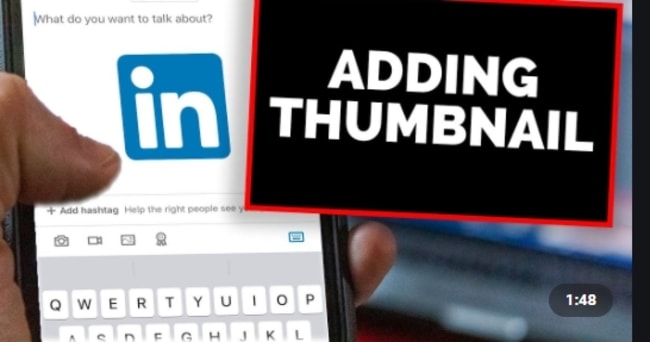
We will guide you through the importance of Linkedin thumbnail, and effective ways to create a thumbnail. Keep reading!!!
In this article
01 [What is a Linkedin Video Thumbnail and Its Size Specifications?](#Part 1)
02 [Publishing Videos On Linkedin](#Part 2)
03 [Ways To Publish Videos On Linkedin](#Part 3)
04 [Importance Of Thumbnails In Linkedin Video](#Part 4)
05 [Tips To Create An Interesting And Effective Linkedin Video Thumbnail](#Part 5)
Part 1 What is a LinkedIn video thumbnail and its size specifications?
A thumbnail for a video is like a preview image of the video and acts like its cover. The viewer will get an idea about what the video contains through its thumbnail image. Though the site chooses the first frame of the video as the thumbnail, you can even set a customized one that is attractive and interesting.
The LinkedIn video thumbnail size specifications are as follows:
● Image size: 1200 X 627 pixels
● Format of the image: JPG or PNG
● Maximum size of the image: 2MB
● Aspect Ratio: The aspect ratio of the thumbnail should match that of the video itself.
Part 2 Publishing videos on LinkedIn
If you are planning to publish a video on LinkedIn, the first thing to know is the place where it will be published. LinkedIn allows adding the videos on the personal feed as well as on the Company pages.
If you are into an established business or a brand having a large number of followers, paid video posts on the company page work best.
For the small- setups and businesses who are looking to promote their products and brands posting a video on the personal feed is a good idea. Initially, you can start by posting on your feed and then can later create a company page.
Part 3 Ways To Publish Videos On Linkedin
After you have decided that whether you will be posting a video on your company page or your personal feed, the next thing is to decide that how the video will be published. There are 3 different ways for posting a video as enlisted below.
● Using YouTube and Vimeo links
If you have your videos on Vimeo or YouTube you can paste their link on your LinkedIn account. To watch the video, a person needs to click on the link and it will then open in the hosting platform.
● Using LinkedIn Native Video
This is the most effective method where a video can be uploaded directly on your LinkedIn account from your system as well as your phone. While posting videos directly on LinkedIn, you can even add customized thumbnails, stickers, subtitles, and titles. A native video will play automatically as it is seen by the people in their feed and thus, they reach a larger number of people.
● Using LinkedIn video ads
To reach the target audience, a sponsored post is also an effective way and the video ads can be posted only through a company page. Depending on the type of product or the brand to be promoted, the video can be created.
Part 4 Importance Of Thumbnails In Linkedin Video
The LinkedIn video thumbnail is one of the important factors that make your video engaging and interesting. Before a person starts watching your video, you need to ensure that they get interested in it and click it. For grabbing this first-time attention, a custom thumbnail works great. You can use any interesting graphic or an image related to your video and edit it to create a customized thumbnail.
A thumbnail can only be used when videos are posted as native LinkedIn videos.
Part 5 Tips To Create An Interesting And Effective Linkedin Video Thumbnail
The following tips will help you create interesting thumbnails for your LinkedIn videos that will grab the viewers’ attention.
● Search for thumbnail templates
There are several sites like Canva, Visme, Postermywall, and others where you can get ready-made templates for creating impressive thumbnails. A variety of designs in different categories are available at these sites to choose from.

● Edit files using an editing tool
To edit the selected template or a fresh image to be used as a thumbnail, you would need a good editing tool. We recommend Wondershare Filmora Video Editor here as excellent software that can edit your files in multiple ways. The software can be downloaded on your Windows and Mac systems in a hassle-free manner and then multiple editing tools can be used to get the desired thumbnail image. Some of the key features supported by the software include enhancing files with effects, rotating, merging, cropping, flipping, adding text & tiles, adding overlays and filters, transitions and elements, motion tracking, color tuning, and much more.
Wondershare Filmora
Get started easily with Filmora’s powerful performance, intuitive interface, and countless effects!
Try It Free Try It Free Try It Free Learn More >

The interface of the software is simple and the process is fast which makes the software perfect for all types of users.
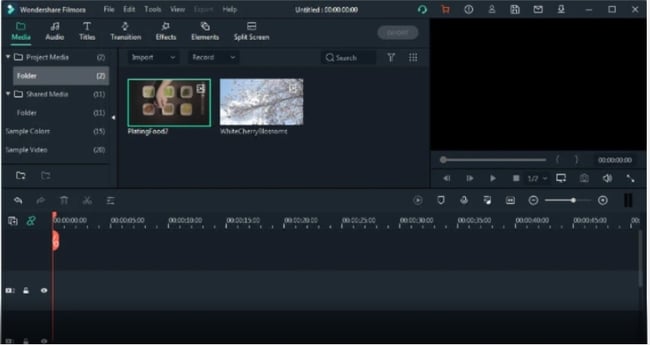
● Keep it simple and uncluttered
The thumbnail should be kept simple and without any clutter. Since LinkedIn is a professional platform there is no need for any unnecessary details needed.
● Let the thumbnail speak of your content
Create a thumbnail that speaks about the content of your video. If the thumbnail is interesting and gives an idea about your video, the viewer will open and watch it.
Key Takeaways from This Episode
● The LinkedIn video thumbnail is a cover image for your videos posted on LinkedIn.
● The videos on LinkedIn can be posted on the company page or as a personal feed.
● The videos can be posted as YouTube or Vimeo links, LinkedIn ads, or as native LinkedIn videos.
● There are several factors to create an effective LinkedIn video thumbnail and one of them is using professional editing software like Wondershare Filmora.
If you have been looking for options to grab the potential of video posting on LinkedIn you are reading on the right page.

We will guide you through the importance of Linkedin thumbnail, and effective ways to create a thumbnail. Keep reading!!!
In this article
01 [What is a Linkedin Video Thumbnail and Its Size Specifications?](#Part 1)
02 [Publishing Videos On Linkedin](#Part 2)
03 [Ways To Publish Videos On Linkedin](#Part 3)
04 [Importance Of Thumbnails In Linkedin Video](#Part 4)
05 [Tips To Create An Interesting And Effective Linkedin Video Thumbnail](#Part 5)
Part 1 What is a LinkedIn video thumbnail and its size specifications?
A thumbnail for a video is like a preview image of the video and acts like its cover. The viewer will get an idea about what the video contains through its thumbnail image. Though the site chooses the first frame of the video as the thumbnail, you can even set a customized one that is attractive and interesting.
The LinkedIn video thumbnail size specifications are as follows:
● Image size: 1200 X 627 pixels
● Format of the image: JPG or PNG
● Maximum size of the image: 2MB
● Aspect Ratio: The aspect ratio of the thumbnail should match that of the video itself.
Part 2 Publishing videos on LinkedIn
If you are planning to publish a video on LinkedIn, the first thing to know is the place where it will be published. LinkedIn allows adding the videos on the personal feed as well as on the Company pages.
If you are into an established business or a brand having a large number of followers, paid video posts on the company page work best.
For the small- setups and businesses who are looking to promote their products and brands posting a video on the personal feed is a good idea. Initially, you can start by posting on your feed and then can later create a company page.
Part 3 Ways To Publish Videos On Linkedin
After you have decided that whether you will be posting a video on your company page or your personal feed, the next thing is to decide that how the video will be published. There are 3 different ways for posting a video as enlisted below.
● Using YouTube and Vimeo links
If you have your videos on Vimeo or YouTube you can paste their link on your LinkedIn account. To watch the video, a person needs to click on the link and it will then open in the hosting platform.
● Using LinkedIn Native Video
This is the most effective method where a video can be uploaded directly on your LinkedIn account from your system as well as your phone. While posting videos directly on LinkedIn, you can even add customized thumbnails, stickers, subtitles, and titles. A native video will play automatically as it is seen by the people in their feed and thus, they reach a larger number of people.
● Using LinkedIn video ads
To reach the target audience, a sponsored post is also an effective way and the video ads can be posted only through a company page. Depending on the type of product or the brand to be promoted, the video can be created.
Part 4 Importance Of Thumbnails In Linkedin Video
The LinkedIn video thumbnail is one of the important factors that make your video engaging and interesting. Before a person starts watching your video, you need to ensure that they get interested in it and click it. For grabbing this first-time attention, a custom thumbnail works great. You can use any interesting graphic or an image related to your video and edit it to create a customized thumbnail.
A thumbnail can only be used when videos are posted as native LinkedIn videos.
Part 5 Tips To Create An Interesting And Effective Linkedin Video Thumbnail
The following tips will help you create interesting thumbnails for your LinkedIn videos that will grab the viewers’ attention.
● Search for thumbnail templates
There are several sites like Canva, Visme, Postermywall, and others where you can get ready-made templates for creating impressive thumbnails. A variety of designs in different categories are available at these sites to choose from.

● Edit files using an editing tool
To edit the selected template or a fresh image to be used as a thumbnail, you would need a good editing tool. We recommend Wondershare Filmora Video Editor here as excellent software that can edit your files in multiple ways. The software can be downloaded on your Windows and Mac systems in a hassle-free manner and then multiple editing tools can be used to get the desired thumbnail image. Some of the key features supported by the software include enhancing files with effects, rotating, merging, cropping, flipping, adding text & tiles, adding overlays and filters, transitions and elements, motion tracking, color tuning, and much more.
Wondershare Filmora
Get started easily with Filmora’s powerful performance, intuitive interface, and countless effects!
Try It Free Try It Free Try It Free Learn More >

The interface of the software is simple and the process is fast which makes the software perfect for all types of users.

● Keep it simple and uncluttered
The thumbnail should be kept simple and without any clutter. Since LinkedIn is a professional platform there is no need for any unnecessary details needed.
● Let the thumbnail speak of your content
Create a thumbnail that speaks about the content of your video. If the thumbnail is interesting and gives an idea about your video, the viewer will open and watch it.
Key Takeaways from This Episode
● The LinkedIn video thumbnail is a cover image for your videos posted on LinkedIn.
● The videos on LinkedIn can be posted on the company page or as a personal feed.
● The videos can be posted as YouTube or Vimeo links, LinkedIn ads, or as native LinkedIn videos.
● There are several factors to create an effective LinkedIn video thumbnail and one of them is using professional editing software like Wondershare Filmora.
If you have been looking for options to grab the potential of video posting on LinkedIn you are reading on the right page.

We will guide you through the importance of Linkedin thumbnail, and effective ways to create a thumbnail. Keep reading!!!
In this article
01 [What is a Linkedin Video Thumbnail and Its Size Specifications?](#Part 1)
02 [Publishing Videos On Linkedin](#Part 2)
03 [Ways To Publish Videos On Linkedin](#Part 3)
04 [Importance Of Thumbnails In Linkedin Video](#Part 4)
05 [Tips To Create An Interesting And Effective Linkedin Video Thumbnail](#Part 5)
Part 1 What is a LinkedIn video thumbnail and its size specifications?
A thumbnail for a video is like a preview image of the video and acts like its cover. The viewer will get an idea about what the video contains through its thumbnail image. Though the site chooses the first frame of the video as the thumbnail, you can even set a customized one that is attractive and interesting.
The LinkedIn video thumbnail size specifications are as follows:
● Image size: 1200 X 627 pixels
● Format of the image: JPG or PNG
● Maximum size of the image: 2MB
● Aspect Ratio: The aspect ratio of the thumbnail should match that of the video itself.
Part 2 Publishing videos on LinkedIn
If you are planning to publish a video on LinkedIn, the first thing to know is the place where it will be published. LinkedIn allows adding the videos on the personal feed as well as on the Company pages.
If you are into an established business or a brand having a large number of followers, paid video posts on the company page work best.
For the small- setups and businesses who are looking to promote their products and brands posting a video on the personal feed is a good idea. Initially, you can start by posting on your feed and then can later create a company page.
Part 3 Ways To Publish Videos On Linkedin
After you have decided that whether you will be posting a video on your company page or your personal feed, the next thing is to decide that how the video will be published. There are 3 different ways for posting a video as enlisted below.
● Using YouTube and Vimeo links
If you have your videos on Vimeo or YouTube you can paste their link on your LinkedIn account. To watch the video, a person needs to click on the link and it will then open in the hosting platform.
● Using LinkedIn Native Video
This is the most effective method where a video can be uploaded directly on your LinkedIn account from your system as well as your phone. While posting videos directly on LinkedIn, you can even add customized thumbnails, stickers, subtitles, and titles. A native video will play automatically as it is seen by the people in their feed and thus, they reach a larger number of people.
● Using LinkedIn video ads
To reach the target audience, a sponsored post is also an effective way and the video ads can be posted only through a company page. Depending on the type of product or the brand to be promoted, the video can be created.
Part 4 Importance Of Thumbnails In Linkedin Video
The LinkedIn video thumbnail is one of the important factors that make your video engaging and interesting. Before a person starts watching your video, you need to ensure that they get interested in it and click it. For grabbing this first-time attention, a custom thumbnail works great. You can use any interesting graphic or an image related to your video and edit it to create a customized thumbnail.
A thumbnail can only be used when videos are posted as native LinkedIn videos.
Part 5 Tips To Create An Interesting And Effective Linkedin Video Thumbnail
The following tips will help you create interesting thumbnails for your LinkedIn videos that will grab the viewers’ attention.
● Search for thumbnail templates
There are several sites like Canva, Visme, Postermywall, and others where you can get ready-made templates for creating impressive thumbnails. A variety of designs in different categories are available at these sites to choose from.

● Edit files using an editing tool
To edit the selected template or a fresh image to be used as a thumbnail, you would need a good editing tool. We recommend Wondershare Filmora Video Editor here as excellent software that can edit your files in multiple ways. The software can be downloaded on your Windows and Mac systems in a hassle-free manner and then multiple editing tools can be used to get the desired thumbnail image. Some of the key features supported by the software include enhancing files with effects, rotating, merging, cropping, flipping, adding text & tiles, adding overlays and filters, transitions and elements, motion tracking, color tuning, and much more.
Wondershare Filmora
Get started easily with Filmora’s powerful performance, intuitive interface, and countless effects!
Try It Free Try It Free Try It Free Learn More >

The interface of the software is simple and the process is fast which makes the software perfect for all types of users.

● Keep it simple and uncluttered
The thumbnail should be kept simple and without any clutter. Since LinkedIn is a professional platform there is no need for any unnecessary details needed.
● Let the thumbnail speak of your content
Create a thumbnail that speaks about the content of your video. If the thumbnail is interesting and gives an idea about your video, the viewer will open and watch it.
Key Takeaways from This Episode
● The LinkedIn video thumbnail is a cover image for your videos posted on LinkedIn.
● The videos on LinkedIn can be posted on the company page or as a personal feed.
● The videos can be posted as YouTube or Vimeo links, LinkedIn ads, or as native LinkedIn videos.
● There are several factors to create an effective LinkedIn video thumbnail and one of them is using professional editing software like Wondershare Filmora.
If you have been looking for options to grab the potential of video posting on LinkedIn you are reading on the right page.

We will guide you through the importance of Linkedin thumbnail, and effective ways to create a thumbnail. Keep reading!!!
In this article
01 [What is a Linkedin Video Thumbnail and Its Size Specifications?](#Part 1)
02 [Publishing Videos On Linkedin](#Part 2)
03 [Ways To Publish Videos On Linkedin](#Part 3)
04 [Importance Of Thumbnails In Linkedin Video](#Part 4)
05 [Tips To Create An Interesting And Effective Linkedin Video Thumbnail](#Part 5)
Part 1 What is a LinkedIn video thumbnail and its size specifications?
A thumbnail for a video is like a preview image of the video and acts like its cover. The viewer will get an idea about what the video contains through its thumbnail image. Though the site chooses the first frame of the video as the thumbnail, you can even set a customized one that is attractive and interesting.
The LinkedIn video thumbnail size specifications are as follows:
● Image size: 1200 X 627 pixels
● Format of the image: JPG or PNG
● Maximum size of the image: 2MB
● Aspect Ratio: The aspect ratio of the thumbnail should match that of the video itself.
Part 2 Publishing videos on LinkedIn
If you are planning to publish a video on LinkedIn, the first thing to know is the place where it will be published. LinkedIn allows adding the videos on the personal feed as well as on the Company pages.
If you are into an established business or a brand having a large number of followers, paid video posts on the company page work best.
For the small- setups and businesses who are looking to promote their products and brands posting a video on the personal feed is a good idea. Initially, you can start by posting on your feed and then can later create a company page.
Part 3 Ways To Publish Videos On Linkedin
After you have decided that whether you will be posting a video on your company page or your personal feed, the next thing is to decide that how the video will be published. There are 3 different ways for posting a video as enlisted below.
● Using YouTube and Vimeo links
If you have your videos on Vimeo or YouTube you can paste their link on your LinkedIn account. To watch the video, a person needs to click on the link and it will then open in the hosting platform.
● Using LinkedIn Native Video
This is the most effective method where a video can be uploaded directly on your LinkedIn account from your system as well as your phone. While posting videos directly on LinkedIn, you can even add customized thumbnails, stickers, subtitles, and titles. A native video will play automatically as it is seen by the people in their feed and thus, they reach a larger number of people.
● Using LinkedIn video ads
To reach the target audience, a sponsored post is also an effective way and the video ads can be posted only through a company page. Depending on the type of product or the brand to be promoted, the video can be created.
Part 4 Importance Of Thumbnails In Linkedin Video
The LinkedIn video thumbnail is one of the important factors that make your video engaging and interesting. Before a person starts watching your video, you need to ensure that they get interested in it and click it. For grabbing this first-time attention, a custom thumbnail works great. You can use any interesting graphic or an image related to your video and edit it to create a customized thumbnail.
A thumbnail can only be used when videos are posted as native LinkedIn videos.
Part 5 Tips To Create An Interesting And Effective Linkedin Video Thumbnail
The following tips will help you create interesting thumbnails for your LinkedIn videos that will grab the viewers’ attention.
● Search for thumbnail templates
There are several sites like Canva, Visme, Postermywall, and others where you can get ready-made templates for creating impressive thumbnails. A variety of designs in different categories are available at these sites to choose from.

● Edit files using an editing tool
To edit the selected template or a fresh image to be used as a thumbnail, you would need a good editing tool. We recommend Wondershare Filmora Video Editor here as excellent software that can edit your files in multiple ways. The software can be downloaded on your Windows and Mac systems in a hassle-free manner and then multiple editing tools can be used to get the desired thumbnail image. Some of the key features supported by the software include enhancing files with effects, rotating, merging, cropping, flipping, adding text & tiles, adding overlays and filters, transitions and elements, motion tracking, color tuning, and much more.
Wondershare Filmora
Get started easily with Filmora’s powerful performance, intuitive interface, and countless effects!
Try It Free Try It Free Try It Free Learn More >

The interface of the software is simple and the process is fast which makes the software perfect for all types of users.

● Keep it simple and uncluttered
The thumbnail should be kept simple and without any clutter. Since LinkedIn is a professional platform there is no need for any unnecessary details needed.
● Let the thumbnail speak of your content
Create a thumbnail that speaks about the content of your video. If the thumbnail is interesting and gives an idea about your video, the viewer will open and watch it.
Key Takeaways from This Episode
● The LinkedIn video thumbnail is a cover image for your videos posted on LinkedIn.
● The videos on LinkedIn can be posted on the company page or as a personal feed.
● The videos can be posted as YouTube or Vimeo links, LinkedIn ads, or as native LinkedIn videos.
● There are several factors to create an effective LinkedIn video thumbnail and one of them is using professional editing software like Wondershare Filmora.
Also read:
- Updated 2024 Approved Free GIF Looping Software for Animated Fun 2023 Review
- Updated VLC Video Playback Hacks How to Play in Slow Motion on Any Device
- Updated In 2024, Elevate Your Video Production Adobe Premiere Pro on Mac
- Updated 2024 Approved Extract Audio From MP4 The Best MP4 to MP3 Converters This Year
- New In 2024, Effortless FLV Video Editing on Windows 8 The Ultimate Guide
- New 2024 Approved Why This Article About Mp3 Converter Windows Deserves to Read?
- New 2024 Approved 10 Free Online Neon Text Creators You Need to Try
- New In 2024, Get Noticed on Facebook The Simple Guide to Optimizing Your Video Aspect Ratios
- New The Art of Flawless Conversion Video to MP3 without Quality Drop for 2024
- Updated In 2024, Cut Like a Pro L-Cuts and J-Cuts in Final Cut Pro X
- New Merge WMV Files with Ease The Best Free Tools for 2024
- Updated 2024 Approved Get the Most Out of Your Videos Top-Rated YouTube to MP3 Converters
- New 2024 Approved Revive Your Videos as Live Photos Best Conversion Tools and Tips
- Updated The Ultimate Mac Video Editor Buying Guide for Newbies
- Updated In 2024, PC Intro Creators Top 10 Tools for Professional-Looking Results
- Updated Windows Movie Maker Alternatives 6 Best Video Editing Software for 2024
- New Seamless Transitions The Art of Color Matching in PowerDirector for 2024
- Updated In 2024, The Science of Screen Resolutions Calculating Pixel Ratios Like a Pro
- New From Snapshots to Cinematic Masterpiece A Video Creation Guide for 2024
- New 2024 Approved Join MOV Files Together for Free 5 Best Software
- New 2024 Approved Unlocking Virtual Reality How to Convert Regular Videos with Ease
- New 2024 Approved This Article Introduces some of the Best Video Apps for Editing Vertical Videos
- New In 2024, The Ultimate Guide to Blurring Videos Online for Free (Updated 2023)
- New In 2024, Best GoPro Quik Alternatives for Desktop and Laptop Users
- New 2024 Approved The Secret to Affordable Final Cut Pro Education Bundles Revealed
- Updated In 2024, Make Me Laugh Best Video Dubbing Apps for Comedy Clips
- Updated MediaMolder for Mac for 2024
- Updated In 2024, 10 Best Desktop and Online Video Trimmers Compared
- Updated In 2024, Smoother Skin in Minutes A Plugin-Free FCPX Editing Technique
- Updated Uncover the Secrets to Choosing the Right YouTube to Audio Converter
- Updated In 2024, Make an Impact Top 10 Intro Creation Websites Free & Paid
- Updated In 2024, Professional Video Editor for Mac OS Unleash Your Creativity
- Updated In 2024, Top Reaction Video Creator Apps for Mobile Devices
- Updated In 2024, Complete Guide to Editing Movies with Appropriate Movie Editors and Tips for Editing Movies and Videos
- Updated Transform Your Photos Into a Breathtaking Video with Final Cut Pro for 2024
- Updated In 2024, Install Linux on Your Chromebook The Ultimate How-To
- Updated Watermark-Free Videos How to Remove Filmora Branding with or without Paying for 2024
- Updated Unleash Your Creativity A Comprehensive Guide to Jaycut Free Video Editing for 2024
- Updated From Zero to Hero Top Free Video Editing Software for 2024
- Disabling iPhone 11 Pro Max Parental Restrictions With/Without Password | Dr.fone
- 10 Fake GPS Location Apps on Android Of your Honor Magic 6 | Dr.fone
- In 2024, How To Unlock a Xiaomi Redmi Note 12T Pro Easily?
- How to retrieve erased videos from Xiaomi Redmi Note 12T Pro
- How to Transfer Text Messages from Vivo X100 Pro to New Phone | Dr.fone
- Simple and Effective Ways to Change Your Country on YouTube App Of your Realme C33 2023 | Dr.fone
- In 2024, How to Detect and Remove Spyware on Apple iPhone X? | Dr.fone
- Guide How To Unbrick a Bricked Realme Narzo 60 5G Phone | Dr.fone
- Top IMEI Unlokers for Apple iPhone 13 Pro Max and Android Phones
- In 2024, iPogo will be the new iSpoofer On Lava Blaze 2 Pro? | Dr.fone
- How to Screen Mirroring Xiaomi 14? | Dr.fone
- 10 Easy-to-Use FRP Bypass Tools for Unlocking Google Accounts On Samsung Galaxy F54 5G
- In 2024, Fixing Foneazy MockGo Not Working On Itel S23+ | Dr.fone
- Bypass Activation Lock From iPhone 7 Plus - 4 Easy Ways
- Title: Updated 2024 Approved Whats Next After Movie Maker? 10+ Video Editing Alternatives
- Author: Isabella
- Created at : 2024-04-29 12:49:43
- Updated at : 2024-04-30 12:49:43
- Link: https://video-creation-software.techidaily.com/updated-2024-approved-whats-next-after-movie-maker-10plus-video-editing-alternatives/
- License: This work is licensed under CC BY-NC-SA 4.0.


